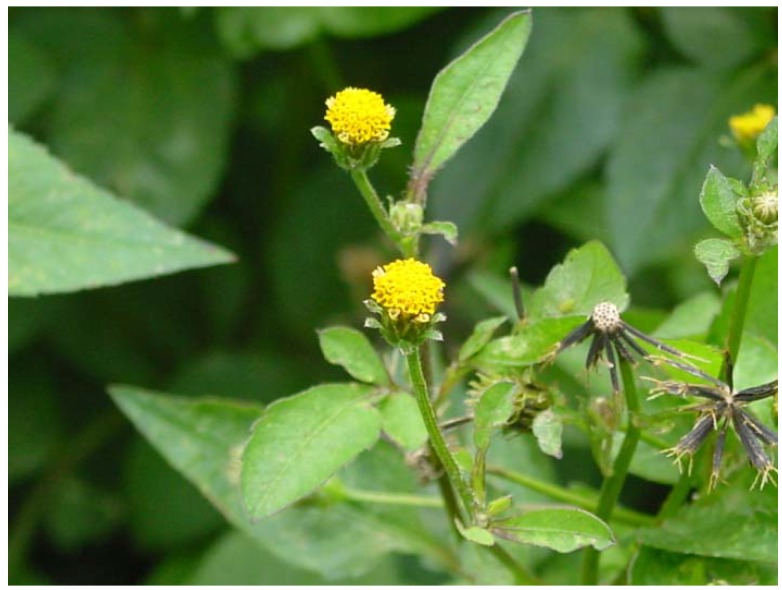Abstract
Bidens pilosa L. is a cosmopolitan annual herb, known for its traditional use in treating various diseases and thus much studied for the biological activity of its extracts, fractions and isolated compounds. Polyacetylenes and flavonoids, typical metabolite classes in the Bidens genus, predominate in the phytochemistry of B. pilosa. These classes of compounds have great taxonomic significance. In the Asteraceae family, the acetylene moiety is widely distributed in the Heliantheae tribe and some representatives, such as 1-phenylhepta-1,3,5-triyne, are noted for their biological activity and strong long-wave UV radiation absorbance. The flavonoids, specifically aurones and chalcones, have been reported as good sub-tribal level markers. Natural products from several other classes have also been isolated from different parts of B. pilosa. This review summarizes the available information on the 198 natural products isolated to date from B. pilosa.
Keywords: Bidens pilosa, Asteraceae, natural products, flavonoids, polyacetylenes
Introduction
The genus Bidens (Asteraceae: Heliantheae) comprises about 240 species with cosmopolitan distribution [1]. Many of these species have been investigated chemically to contribute to the classification of Asteraceae [2,3,4]. Interesting relationships within the Heliantheae, as well as its relationship with other tribes have been proposed on the basis of various types of compounds found in the tribe, especially acetylenes, sesquiterpene lactones and flavonoids [4,5]. The interest in these classes of compounds also has gone beyond chemotaxonomy. The biological activities, including antiparasitic, antifungal and antioxidant properties, of the predominant components in the tribe Heliantheae have been widely reported, and the investigation of these species for the discovery of new active compounds has expanded [6,7,8,9,10,11,12].
Bidens pilosa L. (Figure 1) stands out among the species of the genus due to the large number of natural products characterized in it and the biological activities reported for its extracts, fractions and compounds. Therefore, in continuation of our research on bioactive molecules from the various species of the different families cited [13,14,15,16,17,18,19,20,21,22,23,24,25,26,27,28,29,30,31,32,33,34,35,36,37,38,39,40,41,42,43], we offer this compilation of the chemical constituents of B. pilosa.
Figure 1.
Bidens pilosa L.
Bidens pilosa L.
B. pilosa is an annual, erect and ruderal herb originating from South America and now found in almost all tropical and subtropical region countries [44,45,46]. It grows to a height of up to 1.5 m, branching from the base and its yellow flowers have 5-15 mm diameter [44,46].
It is a cosmopolitan herb, considered invasive of annual and perennial crops and widely distributed in disturbed areas and along roadsides in tropical and subtropical climates [46]. Nevertheless, this plant is commonly used in the traditional medicine. In Martinique, the decoction of the whole plant is used for its anti-inflammatory and hypoglycemic effects [47]. Aqueous preparations of the leaves are used by Zulu people for the treatment of dysentery, diarrhea and colic [48]. B. pilosa has been popularly used in China as a herbal tea ingredient or in traditional medicine for treating various disorders, such as diabetes, inflammation, enteritis, bacillary dysentery and pharyngitis [49]. In Brazil, it is widely used as a folk medicine by indigenous people to treat a variety of illnesses including pain, fever, angina, diabetes, edema, infections and inflammation [50,51]. In addition, in the Amazon and regions in the South of Brazil, hydroalcoholic solutions of B. pilosa roots are also regarded as useful in the treatment of malaria [52] and even tumors [53].
Studies of B. pilosa plant extracts have shown it has anti-hyperglycemic [54,55], antihypertensive [56,57,58], antiulcerogenic [45], hepatoprotective [59], antipyretic [60], immunosuppressive and anti-inflammatory [8,61,62], anti-leukemic [63,64], anti-malarial [50], anti-bacterial [48], antioxidant [65,66] and antitumor [67] effects. These proven biological activities have led countries like Brazil to include B. pilosa in the official list of medicinal plants with potential for development of herbal use by the public health system [68].
Because the biological activities of some extracts and fractions obtained from different parts of B. pilosa, several isolated constituents of the plant have been studied, referring to anti-inflammatory activity, immunosuppressive [44,49,61,69,70], hepatoprotective [59], anti-bacterial [44,71], antifungal [71] anti-malarial [50,71,72], anticancer [72], antiparasitic [73], anti-hyperglycemic activities [49,54,70,74,75,76], anti-angiogenic [77,78], antioxidant [79] and cercaricidal [80].
The Phytochemistry of Bidens pilosa L.
B. pilosa has been extensively studied since the early 1900s. Among the classes of compounds reported polyacetylenes and flavonoids, typical metabolite classes in the Bidens genus, predominate [4,81]. These are also the most reported classes of compounds when referring to the biological activities [49,50,54,61,74,75,82,83]. A number of earlier studies also have reported the isolation of sterols [44,84,85], terpenoids [46,85,86], phenylpropanoids [62,83,87,88,89,90] and hydrocarbons [44,85,91].
There have been a few reviews of B. pilosa [6,51,92,93], however the phytochemical data have not included all classes of metabolites. To date almost 198 compounds have been described from this species. These secondary metabolites are listed in Table 1, where they were grouped based on the classification adopted by a standard reference work, the Dictionary of Natural Products [94].
Table 1.
Compounds isolated from Bidens pilosa L.
| N°. | Name | Alternative name | Structure | Plant part | Country | Ref. |
|---|---|---|---|---|---|---|
| Aliphatic natural products | ||||||
| Saturated unbranched hydrocarbons | ||||||
| 1 | heneicosane | CH3(CH2)19CH3 | AP | Tanzania | [44] | |
| 2 | dodosane | CH3(CH2)20CH3 | AP | Tanzania | [44] | |
| 3 | tricosane | CH3(CH2)21CH3 | AP | Tanzania | [44] | |
| 4 | tetracosane | CH3(CH2)22CH3 | AP | Tanzania | [44] | |
| 5 | pentacosane | CH3(CH2)23CH3 | AP | Tanzania | [44] | |
| 6 | hexacosane | CH3(CH2)24CH3 | AP | Tanzania | [44] | |
| 7 | heptacosane | CH3(CH2)25CH3 | AP | Tanzania | [44] | |
| 8 | octacosane | CH3(CH2)26CH3 | NF | Taiwan | [91] | |
| AP | Tanzania | [44] | ||||
| 9 | nonocosane | CH3(CH2)27CH3 | NF | Taiwan | [91] | |
| AP | Tanzania | [44] | ||||
| 10 | triacontane | CH3(CH2)28CH3 | NF | Taiwan | [91] | |
| AP | Tanzania | [44] | ||||
| 11 | hentriacontane | CH3(CH2)29CH3 | NF | Taiwan | [91] | |
| AP | Tanzania | [44] | ||||
| 12 | dotriacontane | CH3(CH2)30CH3 | NF | Taiwan | [91] | |
| AP | Tanzania | [44] | ||||
| 13 | tritriacontane | CH3(CH2)31CH3 | NF | Taiwan | [91] | |
| AP | Tanzania | [44] | ||||
| Saturated unbranched alcohols | ||||||
| 14 | 2-butoxy-ethanol | CH3(CH2)3OCH2CH2OH | EP | Taiwan | [85] | |
| 15 | tetracosan-1-ol | CH3(CH2)22CH2OH | AP | Tanzania | [44] | |
| 16 | hexacosan-1-ol | CH3(CH2)24CH2OH | AP | Tanzania | [44] | |
| 17 | 1-octacosanol | CH3(CH2)26CH2OH | AP | Tanzania | [44] | |
| 18 | 1-hentriacontanol | CH3(CH2)29CH2OH | NF | Taiwan | [91] | |
| Saturated unbranched carboxylic acids | ||||||
| 19 | tetradecanoic acid | myristic acid | CH3(CH2)12CO2H | AP | Tanzania | [44] |
| 20 | hexadecanoic acid | palmitic acid | CH3(CH2)14CO2H | AP | Tanzania | [44] |
| 21 | octadecanoic acid | stearic acid | CH3(CH2)16CO2H | AP | Tanzania | [44] |
| 22 | eicosanoic acid | arachidic acid | CH3(CH2)18CO2H | AP | Tanzania | [44] |
| 23 | docosanoid acid | behenic acid | CH3(CH2)20CO2H | LF | not stated | [84] |
| Unbranched aliphatic carboxylic acid esters | ||||||
| 24 | 2-butenedioic acid |  |
AP | China | [121] | |
| AP | China | [102] | ||||
| 25 | (Z)-9-octadecenoic acid | oleic acid |  |
AP | Tanzania | [44] |
| 26 | (E)-9-octadecenoic acid | elaidic acid |  |
LF | not stated | [84] |
| 27 | (Z,Z)-9,12-octadecadienoic acid | linolic acid/linoleic acid |  |
AP | Tanzania | [44] |
| EP | Taiwan | [85] | ||||
| 28 | (Z,Z,Z)-9,12,15-octadecatrienoic acid | α-linolenic acid |  |
EP | Taiwan | [85] |
| 29 | (Z,Z)-9,12-octadecadienoic acid, ethyl ester | ethyl linoleate |  |
EP | Taiwan | [85] |
| 30 | (Z,Z,Z)-9,12,15-octadecatrienoic acid, methyl ester | methyl linolenate |  |
EP | Taiwan | [85] |
| 31 | (Z,Z,Z)-9,12,15-octadecatrienoic acid, ethyl ester | ethyl linolenate |  |
EP | Taiwan | [85] |
| 32 | (Z)-9-octadecenoic acid, 2-butoxyethyl ester | 2-butoxyethyl oleate |  |
EP | Taiwan | [85] |
| 33 | 2-butoxyethyl linoleate |  |
EP | Taiwan | [85] | |
| 34 | (Z,Z,Z)-9,12,15-octadecatrienoic acid, butoxyrthyl ester | 2-butoxyethyl linolenate |  |
EP | Taiwan | [85] |
| Acetylenic hydrocarbons | ||||||
| 35 | 1,7E,9E,15E-heptadecatetraene-11,13-diyne | heptadeca-2E,8E,10E,16-tetraen-4,6-diyne |  |
NF | China | [99] |
| 36 | 1,11-tridecadiene-3,5,7,9-tetrayne |  |
RT | not stated | [2] | |
| 37 | 1-tridecaene-3,5,7,9,11-pentayne | pentayneene |  |
LF | not stated | [2] |
| NF | Egypt | [86] | ||||
| 38 | 5-tridecaene-7,9,11-triyne-3-ol |  |
NF | Egypt | [86] | |
| 39 | 2,10,12-tridecatriene-4,6,8-triyn-1-ol |  |
PNS | not stated | [51] | |
| 40 | 2,12-tridecadiene-4,6,8,10-tetrayn-1-ol | 1,11-tridecadiene-3,5,7,9-tetrayn-13-ol |  |
RT | not stated | [2] |
| NF | Egypt | [86] | ||||
| 41 | 2,12-tridecadiene-4,6,8,10-tetraynal | 1,11-tridecadiene-3,5,7,9-tetrayne-13-al |  |
RT | Germany | [122] |
| 42 | 2,12-tridecadiene-4,6,8,10-tetrayn-1-ol,1-acetate | 1,11-tridecadiene-3,5,7,9-tetrayne-13-acetate |  |
RT | not stated | [2] |
| 43 | (5E)-1,5-tridecadiene-7,9-diyn-3,4,12-triol |  |
AP | China | [100] | |
| 44 | (6E,12E)-3-oxo-tetradeca-6,12-dien-8,10-diyn-1-ol |  |
AP | China | [100] | |
| 45 | (E)-5-tridecene-7,9,11-triyne-1,2-diol | 1,2-dihydroxy-5(E)-tridecene-7,9,11-triyne |  |
EP | Taiwan | [78] |
| 46 | (E)-6-tetradecene-8,10,12-triyne-1,3-diol | 1,3-dihydroxy-6(E)-tetradecene-8,10,12-triyne |  |
EP | Taiwan | [77] |
| EP | Taiwan | [65] | ||||
| EP | Taiwan | [78] | ||||
| 47 | (2R,3E,11E)-3,11-tridecadiene-5,7,9-triyne-1,2-diol | safynol |  |
NF | Egypt | [86] |
| NF | China | [99] | ||||
| 48 | 5,7,9,11-tridecatetrayne-1,2-diol | 1,2-dihydroxy-trideca-5,7,9,11-tetrayne |  |
EP | Taiwan | [77] |
| EP | Taiwan | [78] | ||||
| 49 | (R)-3,5,7,9,11-tridecapentayne-1,2-diol | (R)-1,2-dihydroxy-trideca-3,5,7,9,11-pentayne |  |
AP | Japan | [71] |
| 50 | (4E)-1-(hydroxyl-methyl)-4-dodecene-6,8,10-triyn-1-yl-β-D-glucopyranoside | 2-β-D-gluco-pyranosyloxy-1-hydroxy-5(E)-tridecene-7,9,11-triyne |  |
AP | USA | [54] |
| EP | Taiwan | [75] | ||||
| EP | Taiwan | [123] | ||||
| EP | Taiwan | [65] | ||||
| EP | Taiwan | [49] | ||||
| LF | Taiwan | [124] | ||||
| 51 | (4E)-1-(2-hydroxy-ethyl)-4-dodecene-6,8,10-triyn-1-yl-β-D-glucopyranoside | 3-β-D-gluco-pyranosyloxy-1-hydroxy-6(E)-tetradecene-8,10,12-triyne | 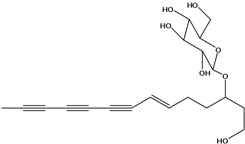 |
AP | USA | [54] |
| AP | China | [102] | ||||
| EP | Taiwan | [75] | ||||
| EP | Taiwan | [123] | ||||
| EP | Taiwan | [65] | ||||
| EP | Taiwan | [49] | ||||
| LF | Taiwan | [124] | ||||
| AP | China | [100] | ||||
| 52 | 3-hydroxy-6-tetra-decene-8,10,12-triynyl-β-D-gluco-pyranoside | β-D-gluco-pyranosyloxy-3-hydroxy-6E-tetradecene-8,10,12-triyne |  |
EP | Mexico | [53] |
| 53 | 1-(hydroxymethyl)-4,6,8,10-dodeca-tetrayn-1-yl-β-D-glucopyranoside | 2-β-D-gluco-pyranosyloxy-1-hydroxytrideca-5,7,9,11-tetrayne , cytopiloyne | 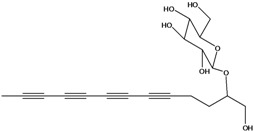 |
EP | Taiwan | [49] |
| EP | not stated | [82] | ||||
| LF | Taiwan | [124] | ||||
| 54 | 2-O-D-glucosyltrideca-11E-en-3,5,7,9-tetrayn-1,2-diol | 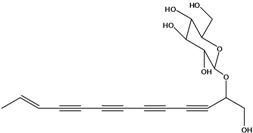 |
LF | Brazil | [61] | |
| 55 | (R)-1-(hydroxy-methyl)-2,4,6,8,10-dodecapentayn-1-yl-β-D-glucopyranoside | 2-β-D-gluco-pyranosyloxy-1-hydroxytrideca-3,5,7,9,11-pentayne | 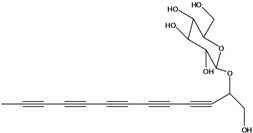 |
AP | China | [102] |
| AP | Japan | [71] | ||||
| 56 | 1-[[(carboxy-acetyl)oxy]methyl]-4,6,8,10-dodeca-tetraynyl-β-D-glucopyranoside | 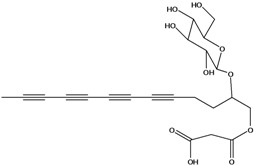 |
AP | Japan | [125] | |
| 57 | (4E)-1-[[(carboxy-acetyl)oxy]-methyl]-4-dodecene-6,8,10-triynyl-β-D-gluco-pyranoside |  |
AP | Japan | [125] | |
| 58 | (4E)-1-[[(carboxy-acetyl)oxy]-ethyl]-4-dodecene-6,8,10-triynyl-β-D-gluco-pyranoside | 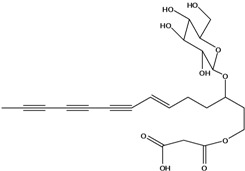 |
AP | Japan | [125] | |
| 59 | (5E)-5-heptene-1,3-diyn-1-yl-benzene | 1-phenylhepta-1,3-diyn-5-en |  |
EP | Taiwan | [85] |
| 60 | 7-phenyl-2(E)-heptene-4,6-diyn-1-ol |  |
RT | not stated | [2] | |
| AP | China | [100] | ||||
| 61 | 7-phenyl-2(E)-heptene-4,6-diyn-1-ol-acetate |  |
RT | not stated | [2] | |
| RT | Brazil | [50] | ||||
| RT | Brazil | [52] | ||||
| 62 | 7-phenyl-4,6-heptadiyn-2-ol | (-)-pilosol A |  |
EPAP | TaiwanChina | [85] |
| [100] | ||||||
| 63 | 7-phenylhepta-4,6-diyn-1,2-diol |  |
AP | China | [100] | |
| 64 | 1,3,5-heptatriyn-1-yl-benzene | 1-phenylhepta-1,3,5-triyne |  |
LF | not stated | [2] |
| LTC | not stated | [97] | ||||
| AP | Tanzania | [44] | ||||
| AP | China | [121] | ||||
| EP | Taiwan | [85] | ||||
| RT | Brazil | [52] | ||||
| AP | China | [100] | ||||
| 65 | 7-phenyl-2,4,6-heptatriyn-1-ol |  |
LF | not stated | [2] | |
| AP | China | [100] | ||||
| 66 | 7-phenyl-2,4,6-heptatriyn-1-ol-acetate |  |
LF | not stated | [2] | |
| 67 | 5-(2-phenylethynyl)-2-thiophene methanol |  |
AP | China | [100] | |
| 68 | 5-(2-phenylethynyl)-2β-glucosylmethyl-thiophene |  |
AP | China | [100] | |
| Simple aromatic hydrocarbons | ||||||
| Simple phenols | ||||||
| 69 | 1,2-benzenediol | pyrocatechin |  |
EP | Japan | [87] |
| 70 | 4-ethyl-1,2-benzenediol | pyrocatechol |  |
EP | Japan | [87] |
| 71 | dimethoxyphenol |  |
RT | Japan | [87] | |
| 72 | 4-ethenyl-2-methoxy-phenol | p-vinylguaiacol |  |
EP | Japan | [87] |
| 73 | 2-hydroxy-6-methylbenzaldehyde | 6-methyl-salicylaldehyde |  |
EP | Japan | [87] |
| 74 | benzene-ethanol | 2-phenyl-ethanol |  |
EP | Taiwan | [85] |
| Simple aryl aldehydes | ||||||
| 75 | 4-hydroxy-3-methoxy-benzaldehyde | vanillin |  |
AP | Japan | [87] |
| 76 | 3-hydroxy-4-methoxy-benzaldehyde | vanillin, iso |  |
LF | Japan | [87] |
| Simple benzoic acids and their homologues | ||||||
| 77 | 4-hydroxy-benzoic acid | p-hydroxybenzoic acid |  |
EP | Japan | [87] |
| 78 | 2-hydroxy-benzoic acid | salicylic acid |  |
ST/RT | Japan | [87] |
| 79 | 3,4-dihydroxy-benzoic acid | protocatechuic acid |  |
EP | Japan | [87] |
| 80 | 4-hydroxy-3-methoxy-benzoic acid | vanillic acid |  |
AP | Uganda | [110] |
| RT | Japan | [87] | ||||
| 81 | 3,4,5-trihydroxy-benzoic acid | gallic acid |  |
EP | China | [126] |
| Phenylpropanoids | ||||||
| Simple phenylpropanoids | ||||||
| 82 | 3-(4-hydroxyphenyl)-2-propenoic acid | p-coumaric acid |  |
EP | Japan | [87] |
| 83 | 2-methoxy-4(2-propen-1-yl)-phenol | eugenol |  |
LF/RT | Japan | [87] |
| 84 | 3-(4-hydroxy-3-methoxyphenyl)-2propenoic acid | ferulic acid |  |
EP | Japan | [87] |
| 85 | 3-(3,4-dihydroxy-phenyl)-2-propenoic acid | caffeic acid |  |
EP | Japan | [87] |
| AP | Japan | [62] | ||||
| 86 | 3-propyl-3-[(2,4,5-trimetoxyphenyl)-methoxy]-2,4-pentanedione | 3-propyl-3-(2,4,5-trimethoxy)benzyloxy-pentan-2,4-dione |  |
LF | India | [90] |
| Coumaric and caffeoyl esters | ||||||
| 87 | 3-(3,4-dihydroxy-phenyl)-2-propenoic acid, ethyl ester | caffeate, ethyl |  |
NF | Taiwan | [127] |
| EP | Taiwan | [65] | ||||
| EP | Taiwan | [78] | ||||
| 88 | 2-[[3-(3,4-dihydroxy-phenyl)-1-oxo-2-propenyl]oxy]-3,4-dihydroxy-2-methyl-butanoic acid | d-erythronic acid, 2-O-caffeoyl-2-C-methyl |  |
LF | Japan | [88] |
| 89 | 2-[[3-(3,4-dihydroxy-phenyl)-1-oxo-2-propenyl]oxy]-3,4-dihydroxy-2-methyl-butanoic acid,methyl ester | d-erythronate, methyl 2-O-caffeoyl-2-C-methyl |  |
LF | Japan | [88] |
| 90 | 3-[[3-(3,4-dihydroxy-phenyl)-1-oxo-2-propenyl]oxy]-2,4-dihydroxy-2-methyl-butanoic acid,methyl ester | d-erythronate, methyl 3-O-caffeoyl-2-C-methyl |  |
LF | Japan | [88] |
| 91 | 4-(acetyloxy)-3-[[3-(3,4-dihydroxyphenyl)-1-oxo-2-propen-1-yl]oxy]-2-hydroxy-2-methyl-butanoic acid |  |
NF | Japan | [70] | |
| 92 | 3-(3,4-dihydroxyphenyl)- tetrahydro-4-hydroxy-4-methyl-5-oxo-3-furanyl ester-2 propenoic acid | 3-O-caffeoyl-2-C-methyl-D-erythrono-1,4-lactone |  |
LF | Japan | [88] |
| 93 | 3-[[3-(3,4-dihydroxyphenyl)-1-oxo-2-propen-1-yl]oxy]-1,4,5-trihydroxy-cyclo-hexanecarboxylic acid | chlorogenic acid | 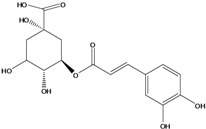 |
AP | Japan | [83] |
| EP | Taiwan | [79] | ||||
| AP | Japan | [62] | ||||
| 94 | 4-[[3-(3,4-dihydroxy-phenyl)-1-oxo-2-propen-1-yl]-oxy]-1,3,5-trihydroxy-cyclo-hexanecarboxylic acid | 4-O-caffeoylquinic acid | 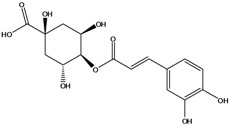 |
AP | Japan | [83] |
| 95 | 3,4-bis[[(2E)-3-(3,4-dihydroxyphenyl)-1-oxo-2-propen-1-yl]-oxy]-1,5-dihydroxy-cyclohexane--carboxylic acid | 3,4-di-O-caffeoylquinic acid |  |
AP | Japan | [83] |
| EP | Taiwan | [79] | ||||
| EP | Taiwan | [75] | ||||
| EP | Taiwan | [65] | ||||
| 96 | 3,5-bis[[(2E)-3-(3,4-dihydroxyphenyl)-1-oxo-2-propen-1-yl]-oxy]-1,4-dihydroxy-cyclohexane-carboxylic acid | 3,5-di-O-caffeoylquinic acid |  |
AP | Japan | [83] |
| EP | Taiwan | [79] | ||||
| EP | Taiwan | [75] | ||||
| EP | Taiwan | [65] | ||||
| 97 | 3,4-bis[[(2E)-3-(3,4-dihydroxyphenyl)-1-oxo-2-propen-1-yl]-oxy]-1,5-dihydroxy-cyclohexane-carboxylic acid | 4,5-di-O-caffeoylquinic acid |  |
EP | Taiwan | [79] |
| EP | Taiwan | [75] | ||||
| EP | Taiwan | [65] | ||||
| 98 | 3-[4-[[6-O-[3-(4-hydroxyphenyl)-1-oxo-2-propen-1-yl]-β-D-glucopyranosyl]-oxy]-phenyl]-2-propenoic acid | β-D-p-coumaric acid, 4-O-(6-O-p-coumaroyl-glucopyranosyl) |  |
LF | Japan | [89] |
| 99 | 3-[4-[[2-O-acetyl-6-O-[3-(4-hydroxyphenyl)-1-oxo-2-propen-1-yl]-β-D-glucopyranosyl]-oxy]-phenyl]-2-propenoic acid | β-D-p-coumaric acid, 4-O-(2-O-acetyl-6-O-p-coumaroyl-glucopyranosyl) |  |
LF | Japan | [89] |
| AP | China | [121] | ||||
| Coumarins | ||||||
| 100 | 6,7-dihydroxy-2H-1-benzopyran-4-one | esculetin |  |
NF | Egypt | [86] |
| Flavonoids | ||||||
| Aurones | ||||||
| 101 | 2-[(3,4-dihydroxy-phenyl)-methylene]-6-hydroxy-3(2H)-benzofuranone | sulfuretin | 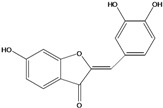 |
AP | China | [102] |
| 102 | 2-[(3,4-dihydroxy-phenyl)-methylene]-6,7-dihydroxy-3(2H)-benzofuranone | aurone, (Z)-6,7,3’,4’-tetrahydroxy; maritimetin | 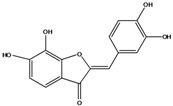 |
AP | China | [102] |
| 103 | 2-[(3,4-dihydroxy-phenyl)-methylene]-6-(β-D-glucopyranos-yloxy)-7-hydroxy-3(2H)-benzofuranone | aurone, (Z)-6-O-β-D-glucopyranosyl-6,7,3',4'-tetrahydroxy; maritimein | 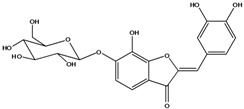 |
LFAPLF | Japan | [89] |
| China | [102] | |||||
| China | [59] | |||||
| 104 | 2-[(3,4-dihydroxy-phenyl)-methylene]-7-(β-D-glucopyranos-yloxy)-6-hydroxy-3(2H)-benzofuranone | aurone, (Z)-7-O-β-D-glucopyranosyl-6,7,3',4'-tetrahydroxy | 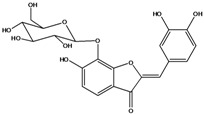 |
LF | Japan | [89] |
| 105 | 6-[(6-O-acetyl-β-D-glucopyranosyl)oxy]-2-[(3,4-dihydroxy-phenyl)-methylene]-7-hydroxy-3(2H)-benzofuranone | aurone, (Z)-6-O-( 6-O-acetyl-β-D-glucopyranosyl)-6,7,3’,4’-tetrahydroxy | 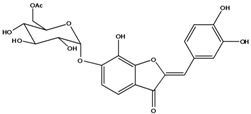 |
LF AP | Japan | [89] |
| China | [102] | |||||
| 106 | 6-[(3,6-di-O-acetyl-β-D-glucopyranosyl)-oxy]-2-[(3,4-di-hydroxyphenyl)-methylene]-7-hydroxy-3(2H)-benzofuranone | aurone, (Z)-6-O-(3,6-di-O-acetyl-D-glucopyranosyl)-6,7,3’,4’-tetrahydroxy; bidenoside A | 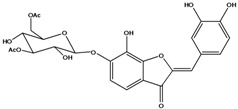 |
LF | China | [59] |
| 107 | 6-[(4,6-di-O-acetyl-β-D-glucopyranosyl)-oxy]-2-[(3,4-di-hydroxyphenyl)-methylene]-7-hydroxy-3(2H)-benzofuranone | aurone, (Z)-6-O-(4”,6”-diacetyl-β-D-glucopyranosyl)-6,7,3’,4’-tetrahydroxy | 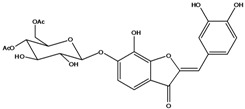 |
LF | not stated | [128] |
| AP | China | [121] | ||||
| AP | China | [102] | ||||
| 108 | 2-[(3,4-dihydroxy-phenyl)-methylene]-7-hydroxy-6-[(2,4,6-tri-O-acetyl-β-D-gluco-pyranosyl)-oxy-3(2H)-benzofuranone] | aurone, (Z)-6-O-(2”,4”,6”-triacetyl-β-D-glucopyranosyl)-6,7,3’,4’-tetrahydroxy | 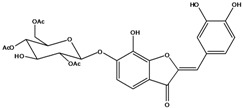 |
LF | not stated | [128] |
| AP | China | [121] | ||||
| 109 | 2-[(3,4-dihydroxy-phenyl)-methylene]-7-hydroxy-6-[(3,4,6-tri-O-acetyl-β-D-gluco-pyranosyl)-oxy]-3(2H)-benzofuranone | aurone, (Z)-6-O-(3”,4”,6”-triacetyl-β-D-glucopyranosyl)-6,7,3’,4’-tetrahydroxy | 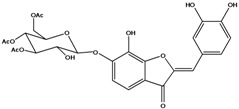 |
AP | China | [121] |
| AP | China | [102] | ||||
| 110 | 2-[(3,4-dihydroxy-phenyl)-methylene]-7-hydroxy-6-[[6-O-[3-(4-hydroxyphenyl)-1-oxo-2-propenyl]-β-D-glucopyranosyl]oxy]-3(2H)-benzofuranone | aurone, (Z)-6-O-(6-O-p-coumaroyl-β-D-glucopyranosyl)-6,7,3',4'-tetrahydroxy | 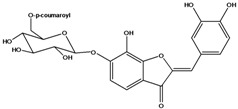 |
LF | Japan | [89] |
| Chalcones | ||||||
| 111 | 1-[2-(β-D-gluco-pyranosyloxy)-4-hydroxyphenyl]-2-hydroxy-3-(3-hydroxyphenyl)- 2-propen-1-one | chalcone, α,3,2’,4’-tetrahydroxy-2’-O-β-D-glucopyranosyl |  |
AP | China | [102] |
| 112 | 1-(2,4-dihydroxy-phenyl)-3-(3,4-dihydroxy-phenyl)-2-propen-1-one | butein | 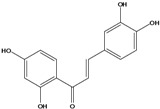 |
AP | China | [102] |
| 113 | 3-(3,4-dihydroxy-phenyl)-1-(2,3,4-trihydroxy-phenyl)-2-propen-1-one | okanin | 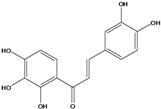 |
LF | China | [59] |
| 114 | 3-(3,4-dihydroxy-phenyl)-1-[3-(β-D-glucopyranosyloxy)-2,4-dihydroxyphenyl]-2-propen-1-one | okanin 3’-O-β-D-glucoside | 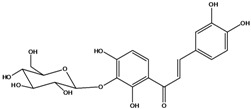 |
LF | Germany | [129] |
| LF | Germany | [130] | ||||
| FL | Germany | [109] | ||||
| 115 | 3-(3,4-dihydroxy-phenyl)-1-[4-(β-D-glucopyranosyloxy)-2,3-dihydroxyphenyl]-2-propen-1-one | okanin 4’-O-β-D-glucopyranoside; marein |  |
FL | Germany | [109] |
| LF | Japan | [89] | ||||
| 116 | okanin 4’-O-β-D-(6”-O-acetylglucoside) | 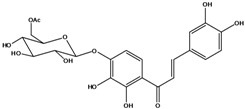 |
FL | Germany | [109] | |
| 117 | 1-[4-[(4,6-di-O-acetyl-β-D-glucopyranosyl)-oxy]-2,3-dihydroxy-phenyl]-3-(3,4-di-hydroxyphenyl)-2-propen-1-one | okanin 4’-O-β-D-(4”,6”-diacetyl)-glucopyranoside |  |
AP | China | [121] |
| 118 | okanin 4’-O-β-D-(2”,4”,6”-triacetyl)-glucoside | 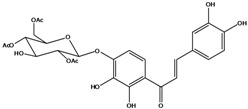 |
LF | Germany | [129] | |
| 119 | okanin 4’-O-β-D-(3”,4”,6”-triacetyl)-glucoside | 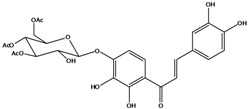 |
AP | China | [121] | |
| 120 | 1-[2,3-dihydroxy-4-[[6-O-[3-(4-hydroxy-phenyl)-1-oxo-2-propenyl]-β-D-glucopyranosyl]oxy]-phenyl]-3-(3,4-dihydroxyphenyl)-2-propen-1-one | okanin 4’-O-β-D-(6”-trans-p-coumaroyl) glucoside |  |
LF | Germany | [129] |
| 121 | okanin 4’-O-β-D-(4”-acetyl-6”-trans-p-coumaroyl)-glucoside |  |
LF | Germany | [131] | |
| 122 | okanin 4’-O-β-D-(2”,4”-diacetyl-6”-trans-p-coumaroyl)-glucoside | 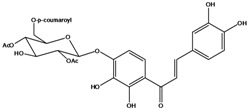 |
LF | Germany | [131] | |
| 123 | okanin 4’-O-β-D-(3”,4”-diacetyl-6”-trans-p-coumaroyl)-glucopyranoside | 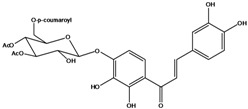 |
LF | Germany | [131] | |
| 124 | okanin 4’-O-[β-D-glucopyranosyl-(1→6)-β-D-glucopyranoside] | 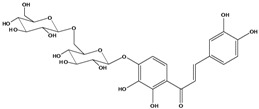 |
FL | Germany | [109] | |
| 125 | okanin 3’,4’-di-O-β-D-glucoside | 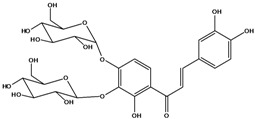 |
FL | Germany | [109] | |
| 126 | 1-[3-(β-D-gluco-pyranosyloxy)-2,4-dihydroxyphenyl]-3-(3-hydroxy-4-methoxyphenyl)-2-propen-1-one | okanin 4-methyl ether-3’-O-β-D-glucopyranoside | 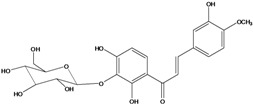 |
LF | Germany | [130] |
| AP | China | [102] | ||||
| 127 | okanin 4-methyl ether-3’,4’-di-O-β-(4”,6”,4’’’,6’’’-tetracetyl)-glucopyranoside | 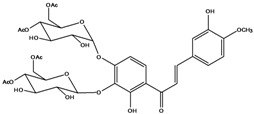 |
AP | China | [100] | |
| 128 | chalcone, 2’,4’,6’-trimethoxy-4-O-D-glucopyranosyl-dihydro | NF | LF | China | [59] | |
| Flavanones | ||||||
| 129 | 2-(3,4-dihydroxy-phenyl)-2,3-dihydro-7,8-dihydroxy-4H-1-benzopyran-4-one | okanin,iso | 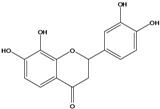 |
LF | China | [59] |
| 130 | 2-(3,4-dihydroxy-phenyl)-2,3-dihydro-8-hydroxy-7-[(2,4,6-tri-O-acetyl-β-D-gluco-pyranosyl)oxy]-4H-1-benzopyran-4-one | okanin 7-O-β-D-(2”,4”,6”-triacetyl)-glucopyranoside, iso | 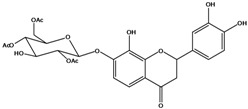 |
AP | China | [121] |
| Flavones | ||||||
| 131 | 5,7-dihydroxy-2-(4-hydroxyphenyl)- 4H-1-benzopyran-4-one | apigenin |  |
AP | Tanzania | [44] |
| AP | China | [100] | ||||
| 132 | 7-(β-D-glucopyranos-yloxy)-5-hydroxy-2-(4-hydroxyphenyl)-4H-1-benzopyran-4-one | apigenin 7-O-glucopyranoside | 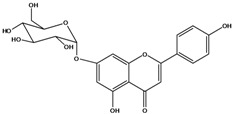 |
AP | Tanzania | [44] |
| 133 | 2-(3,4-dihydroxy-phenyl)-5,7-dihydroxy-4H-1-benzopyran-4-one | luteolin |  |
AP | Tanzania | [44] |
| AP | China | [121] | ||||
| AP | China | [102] | ||||
| AP | China | [100] | ||||
| AP | Vietnam | [132] | ||||
| 134 | 2-(3,4-dihydroxy-phenyl)-7-(β-D-gluco-pyranosyloxy)-5-hydroxy-4H-1-benzopyran-4-one | luteolin 7-O-β-D-glucopyranoside | 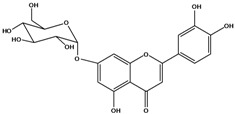 |
AP | Tanzania | [44] |
| 135 | 5,7-dimethoxy-6-(5-methoxy-6-methyl-4-oxo-4H-pyran-3-yl)-2-phenyl-4H-1-benzopyran-4-one | 5-O-methylhoslundin |  |
AP | Uganda | [110] |
| Flavonols | ||||||
| 136 | 3-(β-D-gluco-pyranosyloxy)-5,7-dihydroxy-2-(4-hydroxyphenyl)- 4H-1-benzopyran-4-one | astragalin; kaempferol-3-O-β-D-glucopyranoside |  |
AP | China | [102] |
| 137 | kaempferol 3-(2,3-di-E-p-coumaroyl-α-L-rhamnopyranoside) | NF | AP | Vietnam | [132] | |
| 138 | 2-(3,4-dihydroxy-phenyl)-7-(β-D-glucopyranosyloxy)-5-hydroxy-3,6-dimethoxy-4H-1-benzopyran-4-one | axillaroside |  |
AP | China | [100] |
| 139 | 5,7-dihydroxy-2-(3-hydroxy-4-methoxy-phenyl)-3,6-di-methoxy-4H-1-benzopyran-4-one | centaureidin | 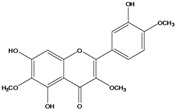 |
EP | Taiwan | [74] |
| 140 | 7-(β-D-glucopyranos-yloxy)-5-hydroxy-2-(3-hydroxy-4-methoxyphenyl)-3,6-dimethoxy-4H-1-benzopyran-4-one | centaurein | 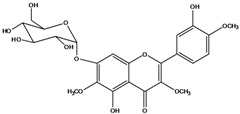 |
AP | Japan | [83] |
| EP | Taiwan | [79] | ||||
| EP | Taiwan | [74] | ||||
| 141 | eupatorin, iso | NF | NF | China | [99] | |
| 142 | 2-(3,4-dimethoxy-phenyl)-7-(β-D-glucopyranosyloxy)-3,5-dihydroxy-8-methoxy-4H-1-benzopyran-4-one | 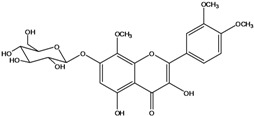 |
NF | Japan | [70] | |
| 143 | 7-(β-D-glucopyranos-yloxy)-5-hydroxy-2-(4-hydroxy-3-methoxyphenyl)-3,8-dimethoxy-4H-1-benzopyran-4-one |  |
NF | Japan | [70] | |
| 144 | isorhamnetin 3-[O-α-L-rhamno-pyranosyl-(1-2)-β-D-glucopyranoside] | NF | AP | Vietnam | [132] | |
| 145 | 7-[(6-deoxy-α-L-mannopyranosyl)oxy]-3-(β-D-glucopyranos-yloxy)-5-hydroxy-2-(4-hydroxy-3-methoxyphenyl)-4H-1-benzopyran-4-one | luteoside | 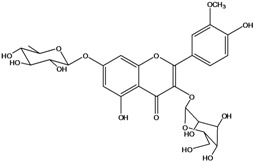 |
AP | China | [100] |
| 146 | luteolin 3-O-β-D-glucopyranoside | 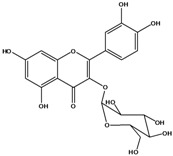 |
AP | Tanzania | [44] | |
| 147 | 5,7-dihydroxy-2-(4-hydroxy-3-methoxy-phenyl)-3,6-di-methoxy-4H-1-benzopyran-4-one | quercetagetin 3,6,3′-trimethyl ether | 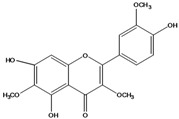 |
AP | China | [100] |
| 148 | quercetagetin 3,7,3’-trimethyl ether-6-O-β-glucoside |  |
AP | China | [100] | |
| 149 | 7-(β-D-glucopyranos-yloxy)-5-hydroxy-2-(4-hydroxy-3-methoxyphenyl)-3,6-dimethoxy-4H-1-benzopyran-4-one | jacein; quercetagetin 3,6,3′-trimethyl ether-7-O-β-glucoside | 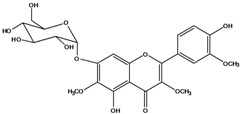 |
AP | Japan | [83] |
| EP | Taiwan | [79] | ||||
| AP | China | [100] | ||||
| 150 | 2-(3,4-dihydroxy-phenyl)-3,5,7-trihydroxy- 4H-1-benzopyran-4-one | quercetin | 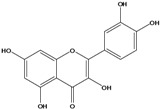 |
AP | China | [102] |
| LF | China | [59] | ||||
| EP | China | [133] | ||||
| 151 | 2-(3,4-dihydroxy-phenyl)-3-(β-D-galactopyranosyloxy)-5,7-dihydroxy-4H-1-benzopyran-4-one | quercetin 3-O-β-D-galactoside; hyperin; hyperoside | 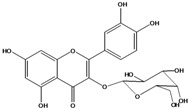 |
AP | Tanzania | [44] |
| AP | Japan | [83] | ||||
| NF | China | [99] | ||||
| AP | Japan | [62] | ||||
| LF | China | [59] | ||||
| EP | China | [133] | ||||
| 152 | 2-(3,4-dihydroxy-phenyl)-3-(β-D-glucopyranosyloxy)-5,7-dihydroxy-4H-1-benzopyran-4-one | quercetin 3-O-β-D-glucopyranoside | 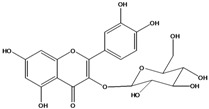 |
AP | Tanzania | [44] |
| LF | Japan | [89] | ||||
| AP | China | [102] | ||||
| AP | Japan | [62] | ||||
| 153 | 2-(3,4-dihydroxy-phenyl)-5,7-dihydroxy-4-oxo-4H-1-benzo-pyran-3-yl-β-D-glucopyranosiduronic acid | quercetin 3-O-β-D-glucuronopyranoside | 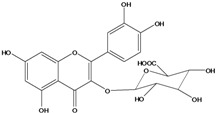 |
AP | Tanzania | [44] |
| AP | Japan | [83] | ||||
| 154 | 3-[[6-O-(6-deoxy-α-L-mannopyranosyl)-β-D-galactopyranosyl]oxy]-2-(3,4-dihydroxy-phenyl)-5,7-dihydroxy- 4H-1-benzopyran-4-one | quercetin 3-O-robinobioside | 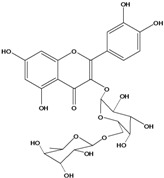 |
AP | Japan | [83] |
| EP | Taiwan | [79] | ||||
| 156 | 7-(β-D-glucopyranos-yloxy)-5-hydroxy-2-(4-hydroxy-3-methoxyphenyl)-3-methoxy-4H-1-benzopyran-4-one | quercetin 3,3’-dimethyl ether 7-O-β-D-glucopyranoside |  |
RT | Brazil | [134] |
| RT | Brazil | [52] | ||||
| RT | Brazil | [135] | ||||
| 157 | 7-[[6-O-(6-deoxy-α-L-mannopyranosyl)-β-D-glucopyranosyl]oxy]-5-hydroxy-2-(4-hydroxy-3-methoxy-phenyl)-3-methoxy-4H-1-benzopyran-4-one | quercetin 3,3’-dimethyl ether 7-O-α-L-rhamnopyranosyl-(1→6)-β-D-glucopyranoside | 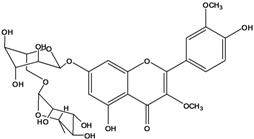 |
RT | Brazil | [134] |
| RT | Brazil | [52] | ||||
| 158 | 7-[[6-O-(6-deoxy-α-L-mannopyranosyl)-β-D-glucopyranosyl]oxy]-5-hydroxy-2-(3-hydroxy-4-methoxy-phenyl)-3-methoxy-4H-1-benzopyran-4-one | quercetin 3,4’-dimethyl ether-7-O-rutinoside |  |
AP | China | [121] |
| AP | China | [102] | ||||
| 159 | 2-(3,4-dihydroxy-phenyl)-3-(β-D-glucofuranosyloxy)-5,7-dihydroxy-4H-1-benzopyran-4-one | isoquercitrin | 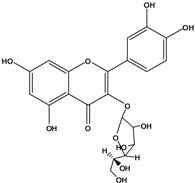 |
AP | Japan | [83] |
| AP | China | [102] | ||||
| Terpenoids | ||||||
| Sesquiterpenes | ||||||
| 160 | 3,7,11,11-tetramethyl-bicyclo[8.1.0]undeca-2,6-diene | bicyclogermacrene |  |
LF | Brazil | [46] |
| 161 | 4,11,11-trimethyl-8-methylenebicyclo-[7.2.0]undec-4-ene | E-caryophyllene |  |
LF | Brazil | [46] |
| 162 | 1-methyl-5-methylene-8-(1-methylethyl)-1,6-cyclodecadiene | germacrene-D |  |
LF | Brazil | [46] |
| 163 | 4-(1,5-dimethyl-4-hexen-1-ylidene)-1-methyl-cyclohexene | Z-γ-bisabolene |  |
LF | Brazil | [46] |
| 164 | decahydro-1,1,4-trimethyl-7-methylene-1H-cycloprop[e]-azulene | β-gurjunene |  |
LF | Brazil | [46] |
| 165 | 2,6,6,9-tetramethyl-1,4,8-cycloundeca-triene | α-humulene;α-caryophyllene |  |
LF | Brazil | [46] |
| 166 | δ-muurolene |  |
LF | Brazil | [46] | |
| 167 | 1,2,3,4,4a,5,6,8a-octahydro-4a,8-dimethyl-2-(1-methylethylidene)-naphthalene | selina-3,7(11)-diene |  |
LF | Brazil | [46] |
| Diterpenes | ||||||
| 168 | (2E,7R,11R)-3,7,11,15-tetramethyl-2-hexadecen-1-ol | phytol |  |
EP | Taiwan | [85] |
| 169 | 3,7,11,15-tetramethyl-2-hexadecenoic acid | phytenic acid |  |
EP | Taiwan | [85] |
| 170 | 3,7,11,15-tetramethyl-2-hexadecenyl ester-heptanoic acid | phythyl heptanoate |  |
LF | not stated | [84] |
| Steroids | ||||||
| 171 | campestrol | 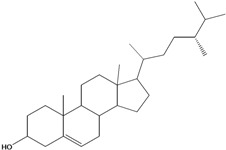 |
AP | Tanzania | [44] | |
| 172 | phytosterin-B | NF | NF | Taiwan | [112] | |
| NF | Egypt | [86] | ||||
| 173 | stigmast-5-en-3-ol | β-sitosterol | 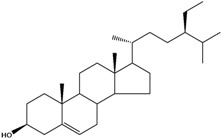 |
NF | Taiwan | [91] |
| AP | Tanzania | [44] | ||||
| EP | Taiwan | [85] | ||||
| 174 | β-sitosterol glucoside | 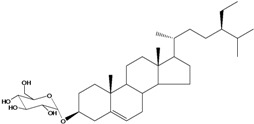 |
NF | Egypt | [86] | |
| 175 | 5α-stigmasta-7-en-3β-ol | 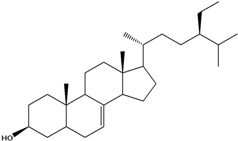 |
EP | Taiwan | [85] | |
| 176 | 5α-stigmasta-7,22t-dien-3β-ol | 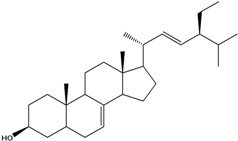 |
EP | Taiwan | [85] | |
| 177 | stigmasta-5,22-dien-3-ol | stigmasterol | 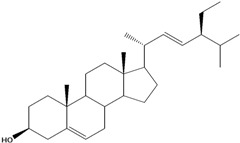 |
NF | Taiwan | [91] |
| AP | Tanzania | [44] | ||||
| LF | not stated | [84] | ||||
| EP | Taiwan | [85] | ||||
| Triterpenes | ||||||
| 178 | lup-20(29)-en-3-ol | lupeol | 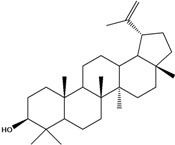 |
NF | Egypt | [86] |
| 179 | lup-20(29)-en-3-ol, acetate | lupeol acetate | 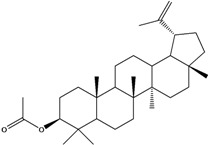 |
NF | Egypt | [86] |
| 180 | olean-12-en-3-ol | β-amirin | 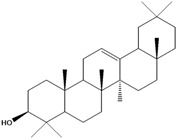 |
NF | Egypt | [86] |
| 181 | 5,9,13-trimethyl-24,25,26-trinoroleanan-3-ol | friedelan-3β-ol | 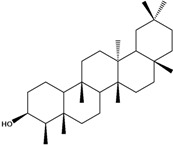 |
AP | Tanzania | [44] |
| 182 | 5,9,13-trimethyl-24,25,26-tri-noroleanan-3-one | friedelin; friedelan-3-one | 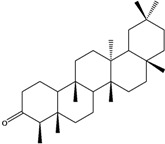 |
AP | Tanzania | [44] |
| 183 | 2,6,10,15,19,23-hexamethyl-2,6,10,14,18,22-tetracosahexaene | squalene |  |
AP | Tanzania | [44] |
| LF | not stated | [84] | ||||
| EP | Taiwan | [85] | ||||
| Tetraterpenes | ||||||
| 184 | β,β-carotene | β-carotene |  |
LF | not stated | [113] |
| Porphyrins | ||||||
| 185 | (2E,7R,11R)-3,7,11,15-tetramethyl-2-hexa-decen-1-yl ester-(15S,16S)-10-ethenyl-5-ethyl-1,16,18,20-tetrahydro-6,11,15,22-tetramethyl-18,20-dioxo-15H-9,12-imino-21,2-metheno-4,7:17,14-dinitrilo-pyrano[4,3-b]azacyclo-nonadecine-16-propanoic acid | aristophyll-C | 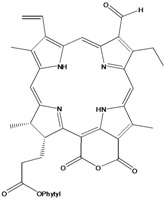 |
LF | Taiwan | [90] |
| 186 | (2E,7R,11R)-3,7,11,15-tetramethyl-2-hexadecen-1-yl ester-(2S,18S,19S,20bR)-13-ethenyl-8-ethyl-2a,18,19,20b-tetrahydro-20b-(methoxycarbonyl)-9,14,18,24-tetra-methyl-4H-12,15-imino-3,5-metheno-7,10:20,17-dinitrilo-1,2-dioxeto-[3',4':3,4]-cyclo-pent[1,2b]aza-cyclo-nonadecine-19-propanoic acid | bidenphytin A | 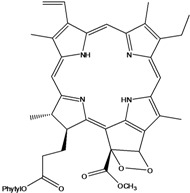 |
LF | Taiwan | [90] |
| 187 | (2E,7R,11R)-3,7,11,15-tetramethyl-2-hexa-decen-1-yl ester-(2S,18S,19S,20bR)-13-ethenyl-8-ethyl-2a,18,19,20b-tetrahydro-2a-hydroxy-20b-(methoxy-carbonyl)-9,14,18,24-tetramethyl-4H-12,15-imino-3,5-metheno-7,10:20,17-dinitrilo-1,2-dioxeto[3',4':3,4]-cyclo-pent[1,2-b]-azacyclononadecine-19-propanoic acid | bidenphytin B | 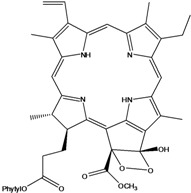 |
LF | Taiwan | [90] |
| 188 | (2E,7R,11R)-3,7,11,15-tetramethyl-2-hexadecen-1-yl ester-(3R,4S,21R)-14-ethyl-21-hydroxy-21-(methoxycarbonyl)-4,8,9,13,18-penta-methyl-20-oxo-3-phorbinepropanoic acid | (132R)-132-hydroxy-pheophytin a | 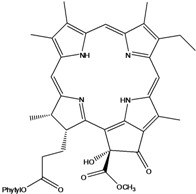 |
LF | Taiwan | [90] |
| 189 | (2E,7R,11R)-3,7,11,15-tetramethyl-2-hexadecen-1-yl ester-(3R,4S,21S)-14-ethyl-21-hydroxy-21-(methoxycarbonyl)-4,8,9,13,18-pentamethyl-20-oxo-3-phorbinepropanoic acid | (132S)-132-hydroxy-pheophytin a | 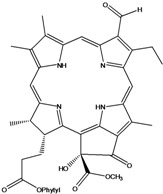 |
LF | Taiwan | [90] |
| 190 | (2E,7R,11R)-3,7,11,15-tetramethyl-2-hexa-decen-1-yl ester-(3R,4S,21R)-14-ethyl-13-formyl-21-hydroxy-21-(methoxycarbonyl)-4,8,9,18-tetramethyl-20-oxo-3-phorbine-propanoic acid, | (132R)-132-hydroxy-pheophytin b | 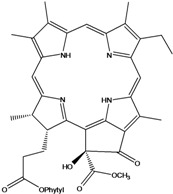 |
LF | Taiwan | [90] |
| 191 | (2E,7R,11R)-3,7,11,15-tetramethyl-2-hexadecen-1-yl ester-(3R,4S,21S)-14-ethyl-13-formyl-21-hydroxy-21-(methoxycarbonyl)-4,8,9,18-tetramethyl-20-oxo-3-phorbine-propanoic acid | (132 S)-132-hydroxy-pheophytin b | 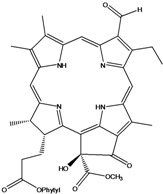 |
LF | Taiwan | [90] |
| 192 | (2E,7R,11R)-3,7,11,15-tetramethyl-2-hexa-decen-1-yl ester-(3S,4S,21R)-9-ethenyl-14-ethyl-21-(methoxy-carbonyl)-4,8,13,18-tetramethyl-20-oxo-3-phorbinepropanoic acid | pheophytin a | 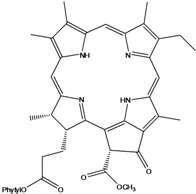 |
LF | Taiwan | [90] |
| Nitrogen and Sulphur-containing Natural Products | ||||||
| 193 | 3,7-dihydro-1,3,7-trimethyl-1H-purine-2,6-dione | caffeine |  |
AP | Uganda | [110] |
| 194 | thymidine | 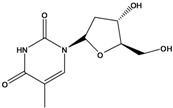 |
NF | China | [99] | |
| 195 | 1-(2-thienyl)-ethanone | 2-acetyl-thiophene |  |
RT | Germany | [122] |
| Carbohydrates/ disaccharides | ||||||
| 196 | heptanyl 2-O-β-xylofuranosyl-(1→6)-β-glucopyranoside |  |
EP | Taiwan | [79] | |
| Miscellaneous | ||||||
| 197 | 2-[(3R,7R,11R)-3-hydroxy-3,7,11,15-tetramethylhexadecyl]-3,5,6-trimethyl-2,5-cyclohexadiene-1,4-dione | α-tocopheryl quinone |  |
EP | Taiwan | [85] |
| 198 | 7-O-(4”,6”-diacetyl)-β-D-glucopyranoside | NF | LF | China | [59] | |
AP, Aerial part; LF, Leaf; ST, Steam; EP, Entire plant; FL, Flowers; RT, Root; SD, Seed; LTC, Leaves of tissue culture; PNS, Part not specified; NF, Not found.
The order begins with the structurally most simple metabolites, derived from aliphatic natural produts (branched, unbranched, saturated or unsaturated hydrocarbons), and among these, the acetylenes are highlighted. Next the derivatives of simple aromatic hydrocarbons and the phenylpropanoids, in which a C3 substituent is attached to the aromatic unit (C6), form a biosynthetically distinct group of aromatic metabolites. The flavonoids, also considered a large group of metabolites in B. pilosa are subdivided into aurones, chalcones, flavanones, flavones and flavonols. The terpenoids group is divided according to the number of carbons, starting in sesquiterpenes and continuing with diterpenes, sterols, triterpenes and finally tetraterpenes. Finally, porphyrins, nitrogen and sulphur-containing natural products, one disaccharide and miscellaneous compounds are arranged.
Acetylene compounds
The acetylenes are one class of aliphatic hydrocarbons that has a taxonomically interesting distribution pattern in higher plant families; they occur regularly in only five families, namely the Campanulaceae, Asteraceae, Araliaceae, Pittosporaceae and Umbelliferae [95]. Within the Asteraceae family, these compounds are widely distributed in the Heliantheae tribe [2,4]. The genus Bidens is known to produce compounds of this class [5]. They occur in all parts of the plant, often accumulating in roots [96].
To date 34 acetylenes (compounds 35–68) were isolated from B. pilosa (Table 1). The C13-polyacetylenes are the most abundant in the species and among them, ene-tetryn-ene 36 and its alcohol, acetyl and aldehyde oxygenated derivatives 40–42, C13-phenylacetylenes 59–66 and C13-acetylenes with an ene-triyn-diene chromophore 39 are typical constituents within the genus Bidens [2,4,96,97].
The principal representative of the C13-polyacetylenes is 1-phenylhepta-1,3,5-triyne (64). This C13-phenylacetylene is abundant in B. pilosa and is present in leaves, stems and roots of the species [5,73,96,97]. The compound is biologically active and several studies have reported that it strongly absorbs long-wave UV radiation, and the activity is altered upon exposure to light (photo activation) [98].
The occurrence of C17-acetylenes is rare in the genus, being limited to the Hawaiian species of Bidens [4], while one compound (35) was related to B. pilosa grown in China [2,99]. Also, three C14-acetylenes 39,44,46, with one (46) being common in species of genus Coreopsis, and another (44), a new compound, were reported first in B. pilosa [4,51,100].
Another group of polyacetylenes isolated from B. pilosa are the polyacetylene glucosides (PAGs), which are glycosides of polyacetylenes in which a sugar moiety (glycose or rhamnose) is joined to a polyacetylene through an -O- glucosidic linkage. Of even more restricted distribution, these have been reported for only two families, Asteraceae and Campanulaceae. So far 22 PAGs are known, however most of them have been isolated from Bidens species [101].
Studies report the isolation of nine PAGs (50–58) from different parts from B. pilosa. Four compounds (50, 53–55) have the common C13-acetylene linkage to glycoside portion in the C2 position [49,54,61,102], however the glycoside derivates of C14-acetylene have the linkage to the glycoside portion in the terminal portion (52) and C3 (51) [53,54]. Other unusual three PAGs have also been reported for B. pilosa. Two C16-acetylenes (56,57) and one C17-acetylene (58) having an ester in the terminal portion linkage to a carboxylic acid [70].
Phenylthiophenes, classified as C13-acetylene and related compounds [4], are related to only occur in Coreopsis and in Hawaiian Bidens [4,103], however a phenylthiophene 67 and its glycosylate 68 were reported for B. pilosa growing in China [100].
Flavonoids
Flavonoids are the class of compound of higher occurrence in the species and are described as chemotaxonomic markers at lower hierarchical levels of the Asteraceae [104]. According to the Bidens genus, the flavonoid profile of B. pilosa is a complex one that includes aurones, chalcones, flavanones, flavones and flavonols with a wide variety of O-methylation patterns and glycosylations [105], totaling 58 different compounds isolated to date (Table 1).
Anthochlors (aurones and chalcones) are found in a number of plant families, including the Asteraceae. However research indicates that, despite some variations, anthochlors are good markers for the taxonomic subtribe Coreopsidinae (Heliantheae tribe), thus representing the only case in the family Asteraceae in which a certain type of flavonoid is taxonomically diagnostic at the sub tribal level [106].
Species of Bidens typically contain the chalcones butein (3,4,3’,4’-tetrahydroxychalcone, 112), okanin (3,4,2’,3’,4’-pentahydroxychalcone, 113) and their 4’-glycosides [3]. Of the aurones, maritimetin (6,7,3',4'-tetrahydroxyaurone, 102) and sulfuretin (6,3',4'-tetrahydroxyaurone, 101) and their glycosides are commonly found in the genus [107]. These compounds have been reported for B. pilosa [108].
In B. pilosa, the glycosides aurones are frequent in position 6 (103–110) and rare in 7 (104) while the glycosides derived from chalcones (111,114–128)are in the positions 3’ and 4’. Two chalcone glycosides, one in position 2’ (111) and other in 4 (128) were also found to the specie [59,102]. Most of these compounds are acylated with p-coumaric and/or acetic acid on the sugar moiety and are relatively non-polar; however more polar aurones (103,104) and chalcones (111,114,115,124,128), mono- and diglucosides were isolated from aerial parts [109]. Two B-ring methylated chalcones (126–127) [80,100] were also found in the species, but this kind of derivatives is rarely reported in the Bidens genus [3].
Flavones and flavonols identified from members of Bidens are for the most part commonly encountered compounds, i.e., glycosides of apigenin, luteolin, kaempferol and quercetin [105]. B. pilosa maintains that standard, however some flavonols present methoxy substitutent groups at their positions 3, 6, 7, 3’ and/or 4’, as in jacein (149), centaureidin (139) and its glycoside centaurein (140) [74,79]. Among the flavones 5-O-methylhoslundin (135) was reported, a compound previously isolated only from Hoslundia opposite (Lamiaceae) [110]. This unusual compound presents methoxy substituted groups in C5 and C7 and a pyranone derivative at C6.
Other compound classes
Several other compound classes have been isolated from different parts of B. pilosa and are listed in Table 1. Among these, aliphatic hydrocarbon derivatives and simple aromatic hydrocarbons have been reported, although these constituents are rather ubiquitous in plants.Long chain saturated unbranched hydrocarbons between C21 and C33 (1–13) have been isolated of B. pilosa [44,91]. Of the saturated unbranched alcohols, the compound 2-butoxyethanol (14) is the only ether-ethanol, while for the unbranched aliphatic carboxylic acid and ester group, three compounds have ether-ester functions (32–34). The simple aromatic hydrocarbons and simple phenylpropanoid compounds form two small groups of natural products in B. pilosa. In the first, vanillic (80), salicylic (78) and protocatechuic (79) acids and their derivatives are predominant [87], while the phenylpropanoids are represented by coumaric (82), ferulic (84) and caffeic (85) acid. In this group, one new disubstituted acetylacetone (86) was described for B. pilosa growing in India [90].
Also in the phenylpropanoids group, caffeoyl ester derivatives 87–97 are fairly reported for the specie, and some esters formed by the combination of two caffeic acids to one quinic acid (93–97) [79,83] or one caffeic acid to one erythronic acid (88–92) [88]. The only coumarin (100) described for B. pilosa is usually found in other species of the family [86].
Of the mevalonate pathway, several sesquiterpenes (160–167), sterols (171–177) and triterpenes (178–183) have been isolated of leaves from B. pilosa [44,51,86]. The sesquiterpenes reported were characterized by GC-MS [46]. These are divided into mono- and bicyclic, commonly found in leaf extracts from Asteraceae. In the diterpenes, acyclic phytane diterpenoids have been reported; among them phytyl heptanoate (170) is an unusual compound that has an aliphatic chain of seven carbon atoms linked to the terminal acid portion [84].
The most abundant sterols from B. pilosa are stigmasterol (177) and sitosterol (173), which are ubiquitous compounds of plant cell membranes [111]. Stigmasterol derivates (175,176), sitosterol glucoside (174) [85,91] and phytosterin B (172), a phytosterin first isolated in B. pilosa [112] has also been reported. Among the triterpenes, only squalene (183) is an acyclic one. The friedelanes 181,182 and lupeol derivatives 178, 179 are the more common triterpenes reported for B. pilosa [44,86]. Among the tetraterpenes β-carotene (184) is reported to be present in high concentration in young leaves of B. pilosa [113].
Chlorin (=2,3-dihydroporphyrin) and its derivatives – including chlorophyll, pheophytin, chlorophyllin, pheophobide, and many other closely related analogues – are found in most higher plants, algae, and even bacteria [114]. For B. pilosa two new pheophytins (186,187), with peroxide functionalities in ring E were reported, besides another six pheophytins (185,188–192), already known [114].
Only two representatives of the class of nitrogen-containing natural products, one being the nucleoside thymidine (194) are reported [122]. One thyophene (195) was reported from B. pilosa [99]. One disaccharide (196) was isolated from an entire B. pilosa. Also, two miscellaneous representatives were reported, a quinone linked to an aliphatic chain (197) [85] and one compound of unidentified structure (198) [59].
The content of essential oil from flowers, leaves and stems of B. pilosa has been analyzed by GC-MS in China, Japan, USA, Cameroon, Nigeria and Iran [66,115,116,117,118,119,120,136]. In this review, the series of components identified as being commonly found in plants containing essential oils and present mostly in very small quantities are not listed. It is then just a brief comment about the main and unusual constituents. In the species a series of mono- and sesquiterpenes have been detected [66,116,117,118,119]. The major constituents are the sesquiterpenes germacrene-D and β-caryophyllene. Polyacetylenes (36,59,60,64), including 1-phenylhepta-1,3,5-tryin (64) have been identified in root oil and aerial parts [117,119]. A chromone, known as precocene I, isolated from oil of the leaves from B. pilosa also was reported [116].
Acknowledgements
The authors are grateful to CNPq/RENORBIO and CAPES/Brazil for financial support and research fellowships.
Footnotes
Sample Availability: Not available.
References
- 1.Karis P.O., Ryding O. In: Asteraceae: Cladistics and Classification. Bremer K., editor. Tember Press; Portland, OR, USA: 1994. pp. 559–569. [Google Scholar]
- 2.Bohlmann F., Burkhardt T., Zdero C. Naturally Occurring Acetylenes. Academic Press; New York, NY, USA: 1973. pp. 356–359. [Google Scholar]
- 3.McCormick S.P., Bohm B.A., Ganders F.R. Methylated chalcones from Bidens torta. Phytochemistry. 1984;23:2400–2401. doi: 10.1016/S0031-9422(00)80570-1. [DOI] [Google Scholar]
- 4.Christensen L.P., Lam J. Acetylenes and related compounds in Heliantheae. Phytochemistry. 1991;30:11–49. doi: 10.1016/0031-9422(91)84096-B. [DOI] [Google Scholar]
- 5.Jensen S.L., Sörensen N.A. Studies related to naturally occurring acetylene compounds. XXIX. Preliminary investigations in the genus Bidens. I. Bidens radiate and Bidens ferulaefolia. Acta Chem. Scand. 1961;15:1885–1891. doi: 10.3891/acta.chem.scand.15-1885. [DOI] [Google Scholar]
- 6.Young P.H., Hsu Y.-J., Yang W.-C. Bidens pilosa L. and its medicinal use. In: Awaad A.S., Singh V.K., Govil J.N., editors. Recent Progress in Medicinal Plants. Vol. 28. Studium Press LLC; New Delhi, India: 2010. pp. 411–426. [Google Scholar]
- 7.Wang Q., Zhang Y.-N., Chen F.-H. Research development in chemical constituents and pharmacological action of total flavonoids of Bidens bipinnata L. Anhui Yiyao. 2009;13:1011–1013. [Google Scholar]
- 8.Aridogan B.C. Immunomodulatory effects of phytocompounds. In: Ahmad I., Aqil F., Owais M., editors. Modern Phytomedicine: Turning Medicinal Plants into Drugs. Wiley-VCH; Dublin, Ireland: 2006. pp. 341–356. [Google Scholar]
- 9.Guerra F., Goyos C. Pharmacology of Mexican antidiabetic plants. III. Action of aceitilla, Bidens leucantha, on normal and diabetic blood sugar. Prensa Med. Mex. 1951;16:7–11. [Google Scholar]
- 10.Astudillo V.A., Davalos V.H., De Jesus L., Herrera G., Navarrete A. Investigation of Alternanthera repens and Bidens odorata on gastrointestinal disease. Fitoterapia. 2008;79:577–580. doi: 10.1016/j.fitote.2008.07.001. [DOI] [PubMed] [Google Scholar]
- 11.Abraham Z., Bhakuni S.D., Garg H.S., Goel A.K., Mehrotra B.N., Patnaik G.K. Screening of Indian plants for biological activity. Part XII. Indian J. Exp. Biol. 1986;24:48–68. [PubMed] [Google Scholar]
- 12.Leonard D.B. Medicine at your Feet: Healing Plants of the Hawaiian Kingdom Bidens spp. (Kïnehi) Roast Duck Producktion; Kapaa-Princeville, HI, USA: 2006. pp. 1–15. [Google Scholar]
- 13.Moura M.D., Torres A.R., Oliveira R.A.G., Diniz M.F.F.M., Barbosa-Filho J.M. Natural products as inhibitors of models of mammary neoplasia. Brit. J. Phytother. 2001;5:124–145. [Google Scholar]
- 14.Moura M.D., Silva J.S., Oliveira R.A.G., Diniz M.F.F.M., Barbosa-Filho J.M. Natural products reported as potential inhibitors of uterine cervical neoplasia. Acta Farm. Bonaerense. 2002;21:67–74. [Google Scholar]
- 15.Silva J.S., Moura M.D., Oliveira R.A.G., Diniz M.F.F.M., Barbosa-Filho J.M. Natural product inhibitors of ovarian neoplasia. Phytomedicine. 2003;10:221–232. doi: 10.1078/094471103321659988. [DOI] [PubMed] [Google Scholar]
- 16.Gonçalves M.C.R., Moura L.S.A., Rabelo L.A., Barbosa-Filho J.M., Cruz H.M.M., Cruz J. atural products inhibitors of HMG CoA reductase. Rev. Bras. Farm. 2000;81:63–71. [Google Scholar]
- 17.Barbosa-Filho J.M., Medeiros K.C.P., Diniz M.F.F.M., Batista L.M., Athayde-Filho P.F., Silva M.S., Cunha E.V.L., Almeida J.R.G.S., Quintans-Júnior L.J. Natural products inhibitors of the enzyme acetylcholinesterase. Rev. Bras. Farmacogn. 2006;16:258–285. doi: 10.1590/S0102-695X2006000200021. [DOI] [Google Scholar]
- 18.Barbosa-Filho J.M., Martins V.K.M., Rabelo L.A., Moura M.D., Silva M.S., Cunha E.V.L., Souza M.F.V., Almeida R.N., Medeiros I.A. Natural products inhibitors of the angiotensin converting enzyme (ACE). A review between 1980-2000. Rev. Bras. Farmacogn. 2006;16:421–446. doi: 10.1590/S0102-695X2006000300021. [DOI] [Google Scholar]
- 19.Almeida R.N., Navarro D.S., Barbosa-Filho J.M. Plants with central analgesic activity. Phytomedicine. 2001;8:310–322. doi: 10.1078/0944-7113-00050. [DOI] [PubMed] [Google Scholar]
- 20.Pereira J.V., Modesto-Filho J., Agra M.F., Barbosa-Filho J.M. Plant and plant-derived compounds employed in prevention of the osteoporosis. Acta Farm. Bonaerense. 2002;21:223–234. [Google Scholar]
- 21.Morais L.C.S.L., Barbosa-Filho J.M., Almeida R.N. Plants and bioactive compounds for the treatment of Parkinson’s disease. Arq. Bras. Fitomed. Cientif. 2003;1:127–132. [Google Scholar]
- 22.Quintans-Júnior L.J., Almeida J.R.G.S., Lima J.T., Nunes X.P., Siqueira J.S., Oliveira L.E.G., Almeida R.N., Athayde-Filho P.F., Barbosa-Filho J.M. Plants with anticonvulsant properties - a review. Rev. Bras. Farmacogn. 2008;18:798–819. doi: 10.1590/S0102-695X2008000500026. [DOI] [Google Scholar]
- 23.Sousa F.C.F., Melo C.T.V., Citó M.C.O., Félix F.H.C., Vasconcelos S.M.M., Fonteles M.M.F., Barbosa-Filho J.M., Viana G.S.B. Plantas medicinais e seus constituintes bioativos: Uma revisão da bioatividade e potenciais benefícios nos distúrbios da ansiedade em modelos animais. Rev. Bras. Farmacogn. 2008;18:642–654. doi: 10.1590/S0102-695X2008000400023. [DOI] [Google Scholar]
- 24.Rocha L.G., Almeida J.R.G.S., Macedo R.O., Barbosa-Filho J.M. A review of natural products with antileishmanial activity. Phytomedicine. 2005;12:514–535. doi: 10.1016/j.phymed.2003.10.006. [DOI] [PubMed] [Google Scholar]
- 25.Amaral F.M.M., Ribeiro M.N.S., Barbosa-Filho J.M., Reis A.S., Nascimento F.R.F., Macedo R.O. Plants and chemical constituents with giardicidal activity. Rev. Bras. Farmacogn. 2006;16:696–720. doi: 10.1590/S0102-695X2006000500017. [DOI] [Google Scholar]
- 26.Barbosa-Filho J.M., Nascimento-Júnior F.A., Tomaz A.C.A., Athayde-Filho P.F., Silva M.S., Cunha E.V.L. Natural products with antileprotic activity. Rev. Bras. Farmacogn. 2007;17:141–148. doi: 10.1590/S0102-695X2007000100022. [DOI] [Google Scholar]
- 27.Barbosa-Filho J.M., Vasconcelos T.H.C., Alencar A.A., Batista L.M., Oliveira R.A.G., Guedes D.N., Falcão H.S., Moura M.D., Diniz M.F.F.M., Modesto-Filho J. Plants and their active constituents from South, Central, and North America with hypoglycemic activity. Rev. Bras. Farmacogn. 2005;15:392–413. doi: 10.1590/S0102-695X2005000400021. [DOI] [Google Scholar]
- 28.Falcão H.S., Lima I.O., Santos V.L., Dantas H.F., Diniz M.F.F.M., Barbosa-Filho J.M., Batista L.M. Review of the plants with anti-inflammatory activity studied in Brazil. Rev. Bras. Farmacogn. 2005;15:381–391. doi: 10.1590/S0102-695X2005000400020. [DOI] [Google Scholar]
- 29.Barbosa-Filho J.M., Piuvezam M.R., Moura M.D., Silva M.S., Lima K.V.B., Cunha E.V.L., Fechine I.M., Takemura O.S. Anti-inflammatory activity of alkaloids: a twenty century review. Rev. Bras. Farmacogn. 2006;16:109–139. doi: 10.1590/S0102-695X2006000100020. [DOI] [Google Scholar]
- 30.Mariath I.R., Falcão H.S., Barbosa-Filho J.M., Sousa L.C.F., Tomaz A.C.A., Batista M.F.F.M., Athayde-Filho P.F., Tavares J.F., Silva M.S., Cunha E.V.L. Plants of the American continent with antimalarial activity. Rev. Bras. Farmacogn. 2009;19:158–192. doi: 10.1590/S0102-695X2009000100026. [DOI] [Google Scholar]
- 31.Falcão H.S., Mariath I.R., Diniz M.F.F.M., Batista L.M., Barbosa- Filho J.M. Plants of the American continent with antiulcer activity. Phytomedicine. 2008;15:132–146. doi: 10.1016/j.phymed.2007.07.057. [DOI] [PubMed] [Google Scholar]
- 32.Falcão H.S., Leite J.A., Barbosa-Filho J.M., Athayde-Filho P.F., Chaves M.C.O., Moura M.D., Ferreira A.L., Almeida A.B.A., Souza-Brito A.R.M., Diniz M.F.F.M., Batista L.M. Gastric and duodenal antiulcer activity of alkaloids: a review. Molecules. 2008;13:3198–3223. doi: 10.3390/molecules13123198. [DOI] [PMC free article] [PubMed] [Google Scholar]
- 33.Mota K.S.L., Dias G.E.N., Pinto M.E.F., Luiz-Ferreira A., Souza-Brito A.R.M., Hiruma-Lima C.A., Barbosa-Filho J.M., Batista L.M. Flavonoids with gastroprotective activity. Molecules. 2009;14:979–1012. doi: 10.3390/molecules14030979. [DOI] [PMC free article] [PubMed] [Google Scholar]
- 34.Ribeiro-Filho J., Falcão H.S., Batista L.M., Barbosa-Filho J.M., Piuvezam M.R. Effects of plant extracts on HIV-1 protease. Curr. HIV Res. 2010;8 doi: 10.2174/157016210793499204. in press. [DOI] [PubMed] [Google Scholar]
- 35.Agra M.F., França P.F., Barbosa-Filho J.M. Synopsis of the plants known as medicinal and poisonous in Northeast of Brazil. Rev Bras Farmacogn. 2007;17:114–140. doi: 10.1590/S0102-695X2007000100021. [DOI] [Google Scholar]
- 36.Agra M.F., Silva K.N., Basílio I.J.L.D., França P.F., Barbosa-Filho J.M. Survey of medicinal plants used in the region Northeast of Brazil. Rev. Bras Farmacogn. 2008;18:472–508. doi: 10.1590/S0102-695X2008000300023. [DOI] [Google Scholar]
- 37.Alves J.S., Castro J.C., Freire M.O., Cunha E.V.L., Barbosa-Filho J.M., Silva M.S. Complete assignment of the 1H and 13C spectra of four triterpenes of the ursane, artane, lupane and friedelane groups. Magn. Reson. Chem. 2000;38:201–206. doi: 10.1002/(SICI)1097-458X(200003)38:3<201::AID-MRC622>3.0.CO;2-0. [DOI] [Google Scholar]
- 38.Andrade N.C., Cunha E.V.L., Silva M.S., Agra M.F., Barbosa-Filho J.M. Terpenoids of the Annonaceae: Distribution and compilation of 13C NMR data. In: Gayathri A., editor. Recent Research Developments in Phytochemistry. Vol. 7. Research Signpost; Kerala, India: 2003. pp. 1–85. [Google Scholar]
- 39.Barbosa-Filho J.M., Sette I.M.F., Cunha E.V.L., Guedes D.N., Silva M.S. Protoberberine alkaloids. In: Cordell G.A., editor. The Alkaloids. Vol. 62. Elsevier Ltd.; London, UK: 2005. pp. 1–75. [DOI] [PubMed] [Google Scholar]
- 40.Barbosa-Filho J.M., Alencar A.A., Nunes X.P., Tomaz A.C.A., Sena-Filho J.G., Athayde-Filho P.F., Silva M.S., Souza M.F.V., Cunha E.V.L. Sources of alpha-, beta-, gamma-, delta- and epsilon-carotenes: A twentieth century review. Rev. Bras. Farmacogn. 2008;18:135–154. doi: 10.1590/S0102-695X2008000100023. [DOI] [Google Scholar]
- 41.Sena-Filho J.G., Duringer J.M., Maia G.L.A., Tavares J.F., Xavier H.S., Silva M.S., Cunha E.V.L., Barbosa-Filho J.M. Ecdysteroids from Vitex species: Distribution and compilation of their 13C-NMR spectral data. Chem. Biodivers. 2008;5:707–713. doi: 10.1002/cbdv.200890067. [DOI] [PubMed] [Google Scholar]
- 42.Vasconcelos S.M.M., Honório-Júnior J.E.R., Abreu R.N.D.C., Silva M.C.C., Barbosa-Filho J.M., Lobato R.F.G. Pharmacologic study of some plant species from the Brazilian Northeast: Calotropis procera, Agava sisalana, Solanum paludosum, Dioscorea cayenensis and Crotalaria retusa. In: Varela A., Ibañez J., editors. Medicinal Plants: Classification, Biosynthesis and Pharmacology. 4rd. Nova Science Publishers, Inc.; New York, NY, USA: 2009. pp. 189–202. [Google Scholar]
- 43.Oliveira S.L., Silva M.S., Tavares J.F., Sena-Filho J.G., Lucena H.F.S., Romero M.A.V., Barbosa-Filho J.M. Tropane alkaloids from genus Erythrorylum: Distribution and compilation of C-NMR spectral data. Chem. Biodivers. 2010;7:302–326. doi: 10.1002/cbdv.200800290. [DOI] [PubMed] [Google Scholar]
- 44.Geissberger P., Séquin U. Constituents of Bidens pilosa L.: Do the components found so far explain the use of this plant in traditional medicine? Acta Tropica. 1991;48:251–261. doi: 10.1016/0001-706X(91)90013-A. [DOI] [PubMed] [Google Scholar]
- 45.Alvarez A., Pomar F., Sevilla M.A., Montero M.J. Gastric antisecretory and antiulcer activities of an ethanolic extract of Bidens pilosa L. var. radiata Schult. Bip. J. Ethnopharmacol. 1999;67:333–340. doi: 10.1016/S0378-8741(99)00092-6. [DOI] [PubMed] [Google Scholar]
- 46.Grombone-Guaratini M.T., Silva-Brandão K.L., Solferini V.N., Semir J., Trigo J.R. Sesquiterpene and polyacetylene profile of Bidens pilosa complex (Asteraceae: Heliantheae) from southeast of Brazil. Biochem. Syst. Ecol. 2005;33:479–486. doi: 10.1016/j.bse.2004.11.005. [DOI] [Google Scholar]
- 47.Longuefosse J.-L., Nossin E. Medical ethnobotany survey in Martinique I. J. Ethnopharmacol. 1996;53:117–142. doi: 10.1016/0378-8741(96)01425-0. [DOI] [PubMed] [Google Scholar]
- 48.Rabe T., van Staden J. Antibacterial activity of South African plants used for medicinal purposes. J. Ethnopharmacol. 1997;56:81–87. doi: 10.1016/S0378-8741(96)01515-2. [DOI] [PubMed] [Google Scholar]
- 49.Chiang Y.-M., Chang C.L.-T., Chang S.-L., Yang W.-C., Shyur L.-F. Cytopiloyne, a novel polyacetylenic glucoside from Bidens pilosa, functions as a T helper cell modulator. J. Ethnopharmacol. 2007;110:532–538. doi: 10.1016/j.jep.2006.10.007. [DOI] [PubMed] [Google Scholar]
- 50.Brandão M.G. L., Krettli A.U., Soares L.S.R., Nery C.G.C., Marinuzzi H.C. Antimalarial activity of extracts and fractions from Bidens pilosa and other Bidens species (Asteraceae) correlated with the presence of acetylene and flavonoid compounds. J. Ethnopharmacol. 1997;57:131–138. doi: 10.1016/S0378-8741(97)00060-3. [DOI] [PubMed] [Google Scholar]
- 51.Valdés H.A.L., Rego H.P.L. Bidens pilosa Linné. Rev. Cubana Plant. Med. 2001;1:28–33. [Google Scholar]
- 52.Krettli A.U., Andrade-Neto V.F., Brandão M.G.L., Ferrari W.M.S. The seach for new antimalarial drugs from plants used to treat fever and malaria or plants ramdomly selected: A review. Mem. I. Oswaldo Cruz. 2001;96:1033–1042. doi: 10.1590/S0074-02762001000800002. [DOI] [PubMed] [Google Scholar]
- 53.Alvarez L., Marquina S., Villarreal M.L., Alonso D., Aranda E., Delgado G. Bioactive polyacetylenes from Bidens pilosa. Planta Med. 1996;62:355–357. doi: 10.1055/s-2006-957902. [DOI] [PubMed] [Google Scholar]
- 54.Ubillas R.P., Mendez C.D., Jolad S.D., Luo J., King S.R., Carlson T.J., Fort D.N. Antihyperglycemic acetylenic glucosides from Bidens pilosa. Planta Med. 2000;66:82–83. doi: 10.1055/s-0029-1243117. [DOI] [PubMed] [Google Scholar]
- 55.Alarcon-Aguilar F.J., Roman-Ramos R., Flores-Saenz J.L., Aguirre-Garcia F. Extracts of four mexican medicinal plants in normal and alloxan-diabetic mice. Phytother. Res. 2002;16:383–386. doi: 10.1002/ptr.914. [DOI] [PubMed] [Google Scholar]
- 56.Dimo T., Azay J., Tan P.V., Pellecuer J., Cros G., Bopelet M., Serrano J.J. Effects of the aqueous and methylene chloride extracts of Bidens pilosa leaf on fructose-hypertensive rats. J. Ethnopharmacol. 2001;76:215–221. doi: 10.1016/S0378-8741(01)00229-X. [DOI] [PubMed] [Google Scholar]
- 57.Dimo T., Rakotonirina S.V., Tan P.V., Azay J., Dongo E., Cros G. Leaf methanol extract of Bidens pilosa prevents and attenuates the hypertension induced by high-fructose diet in Wistar rats. J. Ethnopharmacol. 2002;83:183–191. doi: 10.1016/S0378-8741(02)00162-9. [DOI] [PubMed] [Google Scholar]
- 58.Leandre K.K., Claude A.K.J., Jacques D.Y., Flavien T., Etienne E.E. β-Adrenomimetic actions in the hypotension and vasodilatation induced by a chromatographic active fraction from Bidens pilosa L. (Asteraceae) in mammals. Curr. Bioact. Compd. 2008;4:1–5. doi: 10.2174/157340708784533438. [DOI] [Google Scholar]
- 59.Yuan L.-P., Chen F.-H., Ling L., Dou P.-F., Bo H., Zhong M. M., Xia L.-J. Protective effects of total flavonoids of Bidens pilosa L. (TFB) on animal liver injury and liver fibrosis. J. Ethnopharmacol. 2008;116:539–546. doi: 10.1016/j.jep.2008.01.010. [DOI] [PubMed] [Google Scholar]
- 60.Parimalakrishnan S., Akalanka D., Anton S., Gana D.A., Manavalan R., Sridhar N. Studies of anticancer and antipyretic activity of Bidens pilosa whole plant. Afr. Health Sci. 2006;6:27–30. doi: 10.5555/afhs.2006.6.1.27. [DOI] [PMC free article] [PubMed] [Google Scholar]
- 61.Pereira R.L.C., Ibrahim T., Lucchetti L., Silva A.J.R., Moraes V.L.G. Immunosuppressive and anti-inflammatory effects of methanolic extract and the polyacetylene isolated from Bidens pilosa L. Immunopharmacology. 1999;43:31–37. doi: 10.1016/S0162-3109(99)00039-9. [DOI] [PubMed] [Google Scholar]
- 62.Horiuchi M, Seyama Y. Improvement of the antiinflamatory and antiallergic activity of Bidens pilosa L. var. radiata Scherff treated with enzyme (cellulosine) J. Health Sci. 2008;54:294–301. doi: 10.1248/jhs.54.294. [DOI] [Google Scholar]
- 63.Chang J.-S., Chiang L.-C., Chen C.-C., Liu L.-T., Wang K.-C., Lin C.-C. Antileukemic activity of Bidens pilosa L. var. minor (Blume) Sherff and Houttuynia cordata Thunb. Am. J. Chin. Med. 2001;29:303–312. doi: 10.1142/S0192415X01000320. [DOI] [PubMed] [Google Scholar]
- 64.Rojas J.J., Ochoa V.J., Ocampo S.A., Munoz J.F. Screening for antimicrobial activity of ten medicinal plants used in Colombian folkloric medicine: a possible alternative in the treatment of non-nosocomial infections. BMC Compl. Alternative Med. 2006;6:2. doi: 10.1186/1472-6882-6-2. [DOI] [PMC free article] [PubMed] [Google Scholar]
- 65.Yang H.-L., Chen S.-C., Chang N.-W., Chang J.-M., Lee M.-L., Tsai P.-C., Fu H.-H., Kao W.-W., Chiang H.-C., Wang H.H., Hseu Y.-C. Protection from oxidative damage using Bidens pilosa extracts in normal human erythrocytes. Food Chem. Toxicol. 2006;44:1513–1521. doi: 10.1016/j.fct.2006.04.006. [DOI] [PubMed] [Google Scholar]
- 66.Deba F., Xuan T.D., Yasuda M., Tawata S. Chemical composition and antioxidant, antibacterial and antifungal activities of the essential oils from Bidens pilosa Linn. var. radiata. Food Control. 2008;19:346–352. doi: 10.1016/j.foodcont.2007.04.011. [DOI] [Google Scholar]
- 67.Kviecinski M.R., Felipe K.B., Schoenfelder T., Wiese L.P.L., Rossi M.H., Gonçalez E., Felicio J.D., Filho D.W., Pedrosa R.C. Study of the antitumor potential of Bidens pilosa (Asteraceae) used in Brazilian folk medicine. J. Ethnopharmacol. 2008;117:69–75. doi: 10.1016/j.jep.2008.01.017. [DOI] [PubMed] [Google Scholar]
- 68.Ministério da Saúde. RENISUS - Relação nacional de plantas medicinais de interesse ao SUS. [(Accessed on 30 October 2010)]. Available online: http://portal.saude.gov.br/portal/arquivos/pdf/RENISUS.pdf.
- 69.Pereira R.L.C., Ibrahim T., Lucchetti L., Silva A.J.R., Moraes V.L.G. Immunosuppressive and anti-inflammatory effects of methanolic extract and the polyacetylene isolated from Bidens pilosa L. Immunopharmacology. 1999;43:31–37. doi: 10.1016/S0162-3109(99)00039-9. [DOI] [PubMed] [Google Scholar]
- 70.Bairwa K., Kumar R., Sharma R.J., Roy R.K. An updated review on Bidens Pilosa L. Pharma Chem. 2010;2:325–337. [Google Scholar]
- 71.Tobinaga S., Sharma M.K., Aalbersberg W.G.L., Watanabe K., Iguchi K., Narui K., Sasatsu M., Waki S. Isolation and identification of a potent antimalarial and antibacterial polyacetylene from Bidens pilosa. Planta Med. 2009;75:624–628. doi: 10.1055/s-0029-1185377. [DOI] [PubMed] [Google Scholar]
- 72.Kumari P., Misra K., Sisodia B.S., Faridi U., Srivastava S., Luqman S., Darokar M.P., Negi A.S., Gupta M.M., Singh S.C., Kumar J.K. A promising anticancer and antimalarial component from the leaves of Bidens pilosa. Planta Med. 2009;75:59–61. doi: 10.1055/s-0028-1088362. [DOI] [PubMed] [Google Scholar]
- 73.N’Dounga M., Balansard G., Babadjamian A., David P.T., Gasquet M., Boudon G. Contribution a l’etude de Bidens pilosa L. identification et activite antiparasitaire de la phenyl-1 heptatriyne-1,3,5. Plant. Med. Phytother. 1983;17:65–75. [Google Scholar]
- 74.Chang S.-L., Chiang Y.-M., Chang C. L.-T., Yeh H.-H., Shyur L.-F., Kuo Y.-H., Wu T.-K., Yang W.-C. Flavonoids, centaurein and centaureidin, from Bidens pilosa, stimulate IFN-expression. J. Ethnopharmacol. 2007;112:232–236. doi: 10.1016/j.jep.2007.03.001. [DOI] [PubMed] [Google Scholar]
- 75.Chang S.-L., Chang C.L.-T., Chiang Y.-M., Hsieh R.-H., Tzeng C.-R., Wu T.-K., Sytwu H.-K., Shyur L.-F., Yang W.-C. Polyacetylenic compounds and butanol fraction from Bidens pilosa can modulate the differentiation of helper T cells and prevent autoimmune diabetes in non-obese diabetic mice. Planta Med. 2004;70:1045–1051. doi: 10.1055/s-2004-832645. [DOI] [PubMed] [Google Scholar]
- 76.Yang W.L., Chang L., Yang W. Treating type II diabetes involves administering to subject polyacetylenic compound or a Bidens pilosa preparation obtained by stirring pulverized Bidens pilosa in water at specific temperature to form suspension; and collecting supernatant. 1955701 A. EP Patent. :2008.
- 77.Wu L., Chiang Y., Chuang H., Wang S., Yang G., Chen Y., Lai L., Shyur L.-F. Polyacetylenes function as anti-angiogenic agents. Pharm. Res. 2004;21:2112–2119. doi: 10.1023/B:PHAM.0000048204.08865.41. [DOI] [PubMed] [Google Scholar]
- 78.Wu L.-W., Chiang Y.-M., Chuang H.-C., Lo C.-P., Yang K.-Y., Wang S.-Y., Shyur L.-F. A novel polyacetylene significantly inhibits angiogenesis and promotes apoptosis in human endothelial cells through activation of the CDK inhibitors and caspase-7. Planta Med. 2007;73:655–661. doi: 10.1055/s-2007-981527. [DOI] [PubMed] [Google Scholar]
- 79.Chiang Y., Chuang D., Wang S., Kuo Y., Tsai P., Shyur L. Metabolite profiling and chemopreventive bioactivity of plant extracts from Bidens pilosa. J. Ethnopharmacol. 2004;95:409–419. doi: 10.1016/j.jep.2004.08.010. [DOI] [PubMed] [Google Scholar]
- 80.Graham K., Graham E.A., Towers G.H.N. Cercaricidal activity of phenylheptatriyne and α-terthienyl, naturally occurring compounds in species of Asteraceae (Compositae) Can. J. Zool. 1980;58:1955–1958. doi: 10.1139/z80-268. [DOI] [Google Scholar]
- 81.Christensen L.P., Lam J., Thomasen T.A. A chalcone and other constituents of Bidens tripartitus. Phytochemistry. 1990;29:3155–3156. [Google Scholar]
- 82.Chang C.L.-T., Chang S.-L., Lee Y.-M., Chiang Y.-M., Chuang D.-Y., Kuo H.-K., Yang W.-C. Cytopiloyne, a poliacetylenic glucoside, prevents type 1 diabetes in non-obese diabetic mice. J. Immunol. 2007;178:6984–6993. doi: 10.4049/jimmunol.178.11.6984. [DOI] [PubMed] [Google Scholar]
- 83.Kusano A., Seyama Y., Usami E., Katayose T., Shibano M., Tsukamoto D., Kusano G. Studies on the antioxidant active constituents of the dried powder from Bidens pilosa L. var. radiata Sch. Nat. Med. 2003;57:100–104. [Google Scholar]
- 84.Zulueta M.C.A., Tada M., Ragasa C.Y. A diterpene from Bidens pilosa. Phytochemistry. 1995;38:1449–1450. doi: 10.1016/0031-9422(94)00793-S. [DOI] [Google Scholar]
- 85.Chang M.-H., Wang G.-J., Kuo Y.-H., Lee C.-K. The low polar constituents from Bidens pilosa L. var. minor (Blume) Sherff. J. Chin. Chem. Soc. 2000;47:1131–1136. [Google Scholar]
- 86.Sarg T.M., Ateya A.M., Farrag N.M., Abbas F.A. Constituents and biological activity of Bidens pilosa L. grown in Egypt. Acta Pharm. Hung. 1991;61:317–323. [PubMed] [Google Scholar]
- 87.Deba F., Xuan T.D., Yasuda M., Tawata S. Herbicidal and fungicidal activities and identification of potential phytotoxins from Bidens pilosa L. var. radiata Scherff. Weed Biol. Manag. 2007;7:77–83. doi: 10.1111/j.1445-6664.2007.00239.x. [DOI] [Google Scholar]
- 88.Ogawa K., Sashida Y. Caffeoyl derivatives of a sugar lactone and its hydroxy acid from the leaves of Bidens pilosa. Phytochemistry. 1992;31:3657–3658. doi: 10.1016/0031-9422(92)83752-K. [DOI] [Google Scholar]
- 89.Sashida Y., Ogawa K., Kitada M., Karikome H., Mimaki Y., Shimomura H. New aurone glucosides and new phenylpropanoid glucosides form Bidens pilosa. Chem. Pharm. Bull. 1991;39:709–711. doi: 10.1248/cpb.39.709. [DOI] [Google Scholar]
- 90.Kumar J.K., Sinha A.K. A new disubstituted acetylacetone from the leaves of Bidens pilosa Linn. Nat. Prod. Res. 2003;17:71–74. doi: 10.1080/1478641031000062232. [DOI] [PubMed] [Google Scholar]
- 91.Chen A.H., Lin S.R., Hong C.H. Phytochemical study on Bidens pilosa L. var. Minor. Huaxue. 1975:38–42. [Google Scholar]
- 92.Potawale S.E., Shinde V.M., Harle U.N., Borade S.B., Libi A., Dhalawat H.J., Deshmukh R.S. Bidens pilosa L.: a comprehensive review. Pharmacol. Online. 2008;2:185–196. [Google Scholar]
- 93.Bairwa K., Kumar R., Sharma R.J., Roy R.K. An updated review on Bidens pilosa L. Der Pharma Chemica. 2010;2:325–337. [Google Scholar]
- 94.Buckingham J. Dictionary of Natural Products. Volumes 6 and 7 Chapman and Hall; London, UK: 1994. Introduction to the Type of Compound Index. [Google Scholar]
- 95.Harborne J.B., Baxter H., Moss G.P. Phytochemical Dictionary: A Handbook of Bioactive Compounds from Plants. Taylor & Francis; Philadelphia, PA, USA: 1999. p. 57. Chapter 8. [Google Scholar]
- 96.Towers G.H.N., Wat C.-K. Biological activity of polyacetylenes. Rev. Latinoamer. Quim. 1978;9:162–170. [Google Scholar]
- 97.Wat C.-K., Biswas R.K., Graham E.A., Bohm L., Towers G.H.N. Ultraviolet-mediated cytotoxic activity of phenylheptatriyne from Bidens pilosa L. J. Nat. Prod. 1979;42:103–111. doi: 10.1021/np50001a005. [DOI] [PubMed] [Google Scholar]
- 98.Wat C.-K., Johns T., Towers G.H.N. Phototoxic and antibiotic activities of plants of the Asteraceae used in folk medicine. J. Ethnopharmacol. 1980;2:279–290. doi: 10.1016/S0378-8741(80)81006-3. [DOI] [PubMed] [Google Scholar]
- 99.Wang S., Yang B., Li L., Zhu D., He D., Wang L. Active components of Bidens pilosa L. Zhongcaoyao. 2005;36:20–21. [Google Scholar]
- 100.Wang R., Wu Q.-X., Shi Y.-P. Polyacetylenes and flavonoids from the aerial parts of Bidens pilosa. Planta Med. 2010;76:893–896. doi: 10.1055/s-0029-1240814. [DOI] [PubMed] [Google Scholar]
- 101.Ganjewalaa D., Kumara S., Ambikaa K., Luthrab R. Plant polyacetylenic glycosides occurrence, biosynthesis and biological activities. Pharmacol. Online. 2008;2:113–131. [Google Scholar]
- 102.Zhao A., Zhao Q., Peng L., Zhang J., Lin Z., Sun H. A new chalcone glycoside from Bidens pilosa. Yunnan Zhiwu Yanjiu. 2004;26:121–126. [Google Scholar]
- 103.Marchant Y.Y., Ganders F.R., Wat C.K., Towers G.H.N. Polyacetylenes in Hawaiian Bidens. Biochem. Syst. Ecol. 1984;12:67–78. [Google Scholar]
- 104.Emerenciano V.P., Militão J.S.L.T., Campos C.C., Romoff P., Kaplan M.A.C., Zambon M., Brant A.J.C. Flavonoids as chemotaxonomic markers for Asteraceae. Biochem. Syst. Ecol. 2001;29:947–957. doi: 10.1016/S0305-1978(01)00033-3. [DOI] [PubMed] [Google Scholar]
- 105.Bohman B.A., Stuessy T.F. Flavonoids of the Sunflower Family (Asteraceae) Springer-Verlag; Wien, Austria: 2001. pp. 260–263. Chapter 11. [Google Scholar]
- 106.Crawford D.J., Stuessy T.F. The taxonomic significance of anthochlors in the subtribe Coreopsidinae (Compositae, Heliantheae) Am. J. Bot. 1981;68:107–117. doi: 10.2307/2442998. [DOI] [Google Scholar]
- 107.Isakova T.I., Serbin A.G., Belikov V.V., Chushenko V.N. Flavonoids and polysaccharides of Bidens L. species. Rast. Resur. 1986;22:517–523. [Google Scholar]
- 108.Redl K., Davis B., Bauer R. Chalcone glycosides from Bidens campylotheca. Phytochemistry. 1993;32:218–220. [Google Scholar]
- 109.Hoffmann B., Hölzl J. Chalcone glucosides from Bidens pilosa. Phytochemistry. 1989;28:247–249. [Google Scholar]
- 110.Sarker S.D., Bartholomew B., Nash R.J., Robinson N. 5-O-methylhoslundin: an unusual flavonoid from Bidens pilosa (Asteraceae) Biochem. Syst. Ecol. 2000;28:591–593. doi: 10.1016/S0305-1978(99)00091-5. [DOI] [PubMed] [Google Scholar]
- 111.Brown G.D. The biosynthesis of artemisinin (Qinghaosu) and the phytochemistry of Artemisia annua L. (Qinghao) Molecules. 2010;15:7603–7698. doi: 10.3390/molecules15117603. [DOI] [PMC free article] [PubMed] [Google Scholar]
- 112.Lin L.-L., Wu C.-Y., Hsiu H.-C., Wang M.-T., Chuang H. Diabetes mellitus., I. Hypoglycemic activity of phytosterin on alloxan-diabetic rats. Taiwan Yixuehui Zazhi. 1967;66:58–66. [PubMed] [Google Scholar]
- 113.Benhura M.A.N., Chitsiku I.C. The extractable β-carotene content of Guku (Bidens pilosa) leaves after cooking, drying and storage. Int. J. Food Sci. Technol. 1997;32:495–500. doi: 10.1111/j.1365-2621.1997.tb02123.x. [DOI] [Google Scholar]
- 114.Lee T.-H., Lu C.-K., Kuo Y.-H., Jir-Mehng Lo J.-M., Lee C.-K. Unexpected novel pheophytin peroxides from the leaves of Bidens pilosa. Helv. Chim. Acta. 2008;91:79–84. doi: 10.1002/hlca.200890016. [DOI] [Google Scholar]
- 115.Sakuda Y. Constituents of essential oils from Bidens pilosa L. and Ambrosia trifida L. Kochi Joshi Daigaku Kiyo, Shizen Kagakuhen. 1988;36:1–5. [Google Scholar]
- 116.Zollo P.H.A., Kuiate J.R., Menut C., Lamaty G., Bessiere J.M., Chalchat J.C., Garry R. Aromatic plants of tropical central Africa. Part XX. The occurence of 1-phenylhepta-1,3,5-triyne in the essential oil of Bidens pilosa L. from Cameroon. Flavour Frag. J. 1995;10:97–100. doi: 10.1002/ffj.2730100208. [DOI] [Google Scholar]
- 117.Qin J., Chen T., Chen S., Lu Q. Analysis of essential oil of Bidens pilosa L. by GC-MS. Fenxi Ceshi Xuebao. 2003;22:85–87. [Google Scholar]
- 118.Dong L., Yang J., Wang X. Analysis of components of volatile oil from Bidens pilosa. Xinxiang Yixueyuan Xuebao. 2004;21:179–180. [Google Scholar]
- 119.Priestap H.A., Bennett B.C., Quirke J.M.E. Investigation of the essential oils of Bidens pilosa var. minor, Bidens alba and Flaveria linearis. J. Essent. Oil Res. 2008;20:396–402. [Google Scholar]
- 120.Riahi S., Ganjali M.R., Pourbasheer E., Norouzi P. QSRR study of GC retention indices of essential - oil compounds by multiple linear regression with a genetic algorithm. Chromatographia. 2008;67:917–922. doi: 10.1365/s10337-008-0608-4. [DOI] [Google Scholar]
- 121.Wang J., Yang H., Lin Z.W., Sun H.D. Flavonoids from Bidens pilosa var. radiata. Phytochemistry. 1997;46:1275–1278. [Google Scholar]
- 122.Bohlmann F., Bornowski H., Kleine K.M. New polyynes from the tribe Heliantheae. Chem. Ber. 1964;97:2135–2138. doi: 10.1002/cber.19640970806. [DOI] [Google Scholar]
- 123.Chang C.L.-T., Kuo H.-K., Chang S.-L., Chiang Y.-M., Lee T.-H., Wu W.-M., Shyur L.F., Yang W.-C. The distinct effects of a butanol fraction of Bidens pilosa plant extract on the development of Th1-mediated diabetes and Th2-mediated airway inflammation in mice. J. Biomed. Sci. 2005;12:79–89. doi: 10.1007/s11373-004-8172-x. [DOI] [PubMed] [Google Scholar]
- 124.Chien S.-C., Young P.H., Hsu Y.-J., Chen C.-H., Tien Y.-J., Shiu S.-Y., Li T.-H., Yang C.-W., Marimuthu P., Tsai L.F.-L., Yang W.-C. Anti-diabetic properties of three common Bidens pilosa variants in Taiwan. Phytochemistry. 2009;70:1246–1254. doi: 10.1016/j.phytochem.2009.07.011. [DOI] [PubMed] [Google Scholar]
- 125.Kusano G., Kusano A., Seyama Y. Novel hypoglycemic and antiinflammatory polyacetylenic compounds, their compositions, Bidens plant extract fractions, and compositions containing the plant or the fraction. 2004083463 A. :2004.
- 126.Xia Q., Liu Yuan, L. Y. Determination of gallic acid from different species and different medical parts of herba Bidens by RP-HPLC. Huaxi Yaoxue Zazhi. 2009;24:308–310. [Google Scholar]
- 127.Chiang Y.-M., Lo C.-P., Chen Y.-P., Wang S.-Y., Yang N.-S., Kuo Y.-H., Shyur L.-F. Ethyl caffeate suppresses NF-α B activation and its downstream inflammatory mediators, iNOS, COX-2, and PGE2 in vitro or in mouse skin. Br. J. Pharmacol. 2005;146:352–363. doi: 10.1038/sj.bjp.0706343. [DOI] [PMC free article] [PubMed] [Google Scholar]
- 128.Hoffmann B., Hölzl J. Acylated compounds from Bidens pilosa. Planta Med. 1989;55:108–109. doi: 10.1055/s-2006-961881. [DOI] [Google Scholar]
- 129.Hoffmann B., Hölzl J. New chalcones from Bidens pilosa. Planta Med. 1988:52–54. doi: 10.1055/s-2006-962335. [DOI] [PubMed] [Google Scholar]
- 130.Hoffmann B., Hölzl J. A methylated chalcone glucoside from Bidens pilosa. Phytochemistry. 1988;27:3700–3701. doi: 10.1016/0031-9422(88)80806-9. [DOI] [Google Scholar]
- 131.Hoffmann B., Hölzl J. Weitere acylierte chalkone aus Bidens pilosa. Planta Med. 1988:450–451. doi: 10.1055/s-2006-962497. [DOI] [PubMed] [Google Scholar]
- 132.Pham V.V., Pham T.K., Hoang V.L., Phan V.K. Flavonoid compounds from the plant Bidens pilosa L. (Asteraceae) Tap Chi Duoc Hoc. 2010;50:48–53. [Google Scholar]
- 133.Xia Q., Liu Y., Li Y. Determination of hyperoside in different parts and different species of herba Bidens by RP-HPLC. Huaxi Yaoxue Zazhi. 2009;24:82–83. [Google Scholar]
- 134.Brandão M.G.L., Nery C.G.C., Mamão M.A.S., Krettli A.U. Two methoxylated flavone glycosides from Bidens pilosa. Phytochemistry. 1998;48:397–399. [Google Scholar]
- 135.Oliveira F.Q., Andrade-Neto V., Krettli A.U., Brandão M.G.L. New evidences of antimalarial activity of Bidens pilosa roots extract correlated with polyacetylene and flavonoids. J. Ethnopharmacol. 2004;93:39–42. doi: 10.1016/j.jep.2004.03.026. [DOI] [PubMed] [Google Scholar]
- 136.Ogunbinu A.O., Flamini G., Cioni P.L., Adebayo M.A., Ogunwande I.A. Constituents of Cajanus cajan (L.) Millsp., Moringa oleifera Lam., Heliotropium indicum L. and Bidens pilosa L. from Nigeria. Nat. Prod. Commun. 2009;4:573–578. [PubMed] [Google Scholar]



